

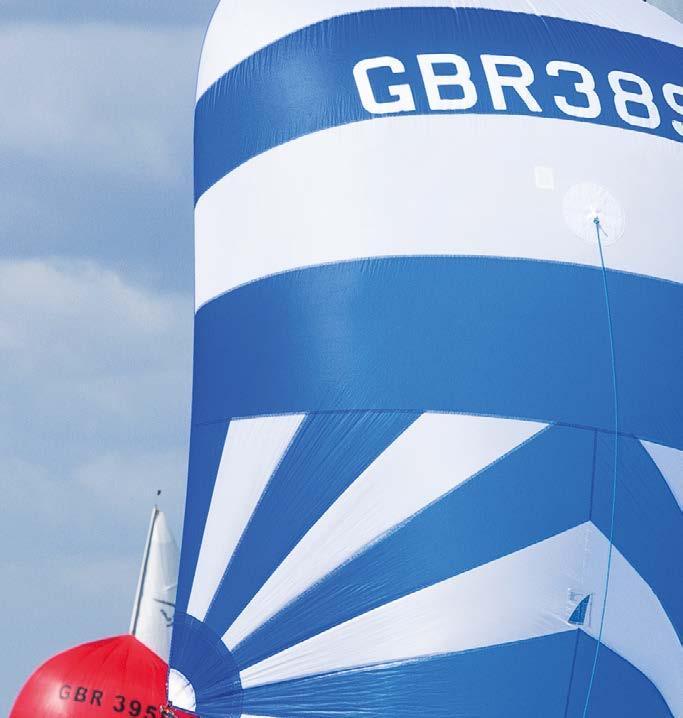
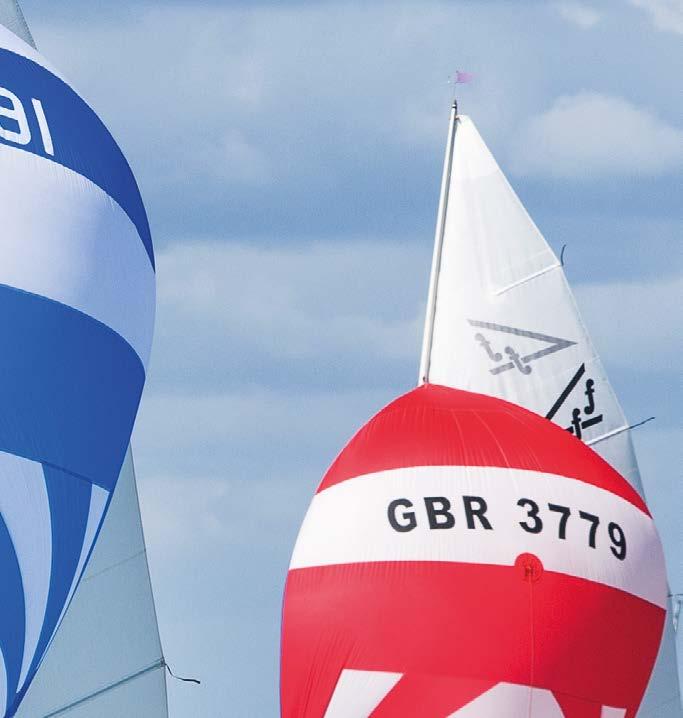
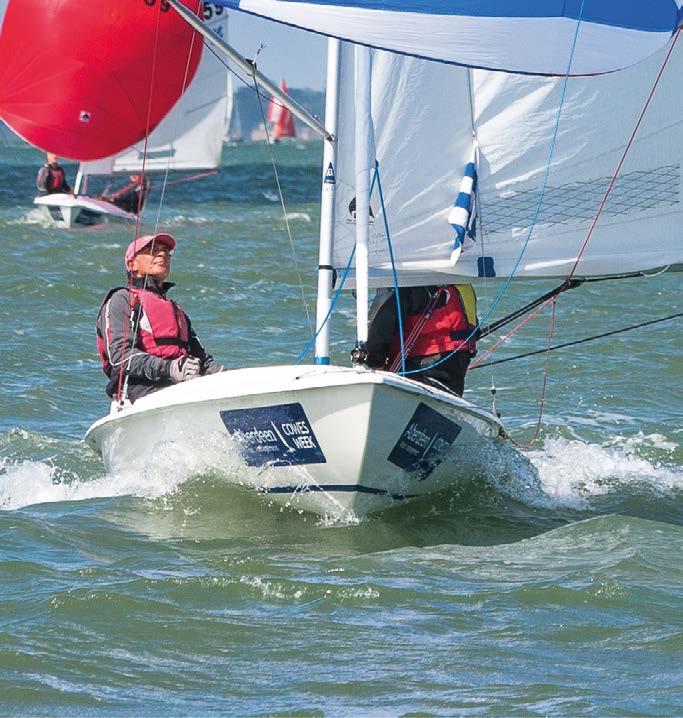
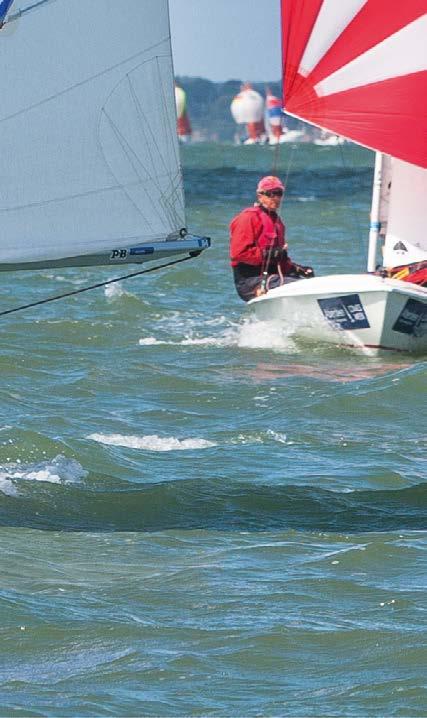
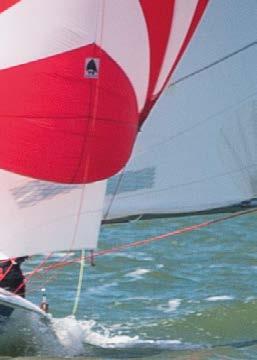


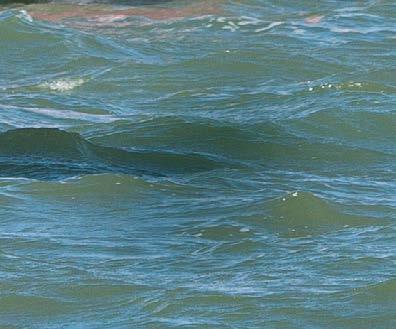
World FEBRUARY 2022 INTERNATIONAL FLYING FIFTEEN
ff
Exclusive craft insurance for Members of the UK Flying
Exclusive craft insurance for Members of the UK Flying 15 Association
Exclusive craft insurance for Members of the UK Flying 15 Association

15 Association
The UK Flying 15 Association insurance scheme is designed to protect your Flying 15 craft and your liability to third parties.
The UK Flying 15 Association insurance scheme is designed to protect your Flying 15 craft and your liability to third parties.
The UK Flying 15 Association insurance scheme is designed to protect your Flying 15 craft and your liability to third parties.
It provides members with bespoke benefits, such as new-for-old cover on sails, masts, spars and rigging. In addition, our scheme wording does not have a Hitchlock and Clamping condition.
It provides members with bespoke benefits, such as new-for-old cover on sails, masts, spars and rigging. In addition, our scheme wording does not have a Hitchlock and Clamping condition.
It provides members with bespoke benefits, such as new-for-old cover on sails, masts, spars and rigging. In addition, our scheme wording does not have a Hitchlock and Clamping condition.
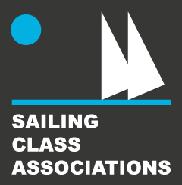


As well as providing exclusive benefits and competitive premiums, with an additional £20 discount for UKFFA members*, the scheme provides important income for the Association, which helps fund activities for members.
As well as providing exclusive benefits and competitive premiums, with an additional £20 discount for UKFFA members*, the scheme provides important income for the Association, which helps fund activities for members.
As well as providing exclusive benefits and competitive premiums, with an additional £20 discount for UKFFA members*, the scheme provides important income for the Association, which helps fund activities for members.
For a personal quote, please contact:
Why not
Why not call us for a free quotation for your club’s insurance programme?
Why not call us for a free quotation for your club’s insurance programme?
We
We may be able to reduce your premium costs as well as reviewing your cover to ensure your club has the protection it needs.
We may be able to reduce your premium costs as well as reviewing your cover to ensure your club has the protection it needs.
For a personal quote, please contact:
For a personal quote, please contact:
Jerry Dungate
Jerry Dungate
Jerry Dungate
T: 01883 333512
T: 01883 333512
T: 01883 333512
E: jerry.dungate@ukglobalgroup.co.uk
E: jerry.dungate@ukglobalgroup.co.uk
E: jerry.dungate@ukglobalgroup.co.uk

W: www.ukglobalgroup.co.uk
W: www.ukglobalgroup.co.uk
W: www.ukglobalgroup.co.uk
*A £20 administration fee is removed each year for members of the UKFFA. UKGlobal Insurance Brokers, UKGlobal and UKGlobal Group are trading names of UKGlobal Risk Solutions Limited. UKGlobal Risk Solutions Limited is an Appointed Representative of UKGlobal Broking Group Limited, which is authorised and regulated by the Financial Conduct Authority (reference number 840855). The United Kingdom Flying Fifteen Association is an Introducer Appointed Representative of UKGlobal Broking Group Limited. Marketing Info - 12.11.21
*A £20 administration fee is removed each year for members of the UKFFA. UKGlobal Insurance Brokers, UKGlobal and UKGlobal Group are trading names of UKGlobal Risk Solutions Limited. UKGlobal Risk Solutions Limited is an Appointed Representative of UKGlobal Broking Group Limited, which is authorised and regulated by the Financial Conduct Authority (reference number 840855). The United Kingdom Flying Fifteen Association is an Introducer Appointed Representative of UKGlobal Broking Group Limited. Marketing Info - 12.11.21
call us for a free quotation for your club’s insurance programme?
may be able to reduce your premium costs as well as reviewing your cover to ensure your club has the protection it needs.
*A £20 administration fee is removed each year for members of the UKFFA. UKGlobal Insurance Brokers, UKGlobal and UKGlobal Group are trading names of UKGlobal Risk Solutions Limited. UKGlobal Risk Solutions Limited is an Appointed Representative of UKGlobal Broking Group Limited, which is authorised and regulated by the Financial Conduct Authority (reference number 840855). The United Kingdom Flying Fifteen Association is an Introducer Appointed Representative of UKGlobal Broking Group Limited. Marketing Info - 12.11.21
Editor’s Comments FF World Feb 2022
Having lost a year, I have tried to ensure this edition comes back with a bang and showcases our beautiful boats and the many stories behind them. I wish to thank all of this year’s contributors.
Trying to live up to the title FF World, I have invited contributions from fleets in other countries to show we are not just a UK phenomenon and to act as a publicity vehicle for all our fleets around the world. I hope you enjoy this extended view.
I have featured the best content from the UKFFA website as it bears repeating via a different channel for those who do not look at websites, follow social media and to ensure some longevity in print.
I also invite overseas fleets to contribute money in exchange for hard copies of the magazine as these are useful “leave behinds” to further the knowledge of the boat to the “great uneducated”. All editions of FF World are available to view at https://issuu.com/flying15international/docs.
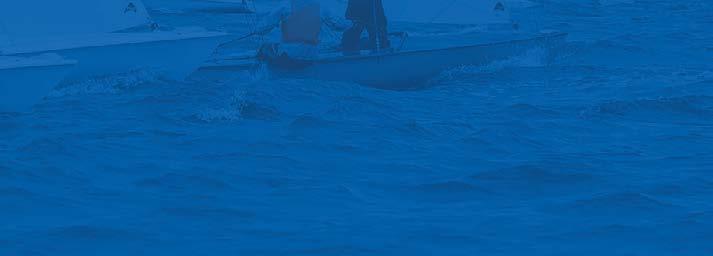
All this is well and good but as a fl eet we also face a challenge that having enhanced our popularity there is a great shortage of second-hand boats on the marketplace.
As at the time of writing (December 2021), the UK website had no second-hand boast listed for sale of any age! This is a first. One cause may be a production squeeze at existing builders and not enough new builders, the days of the “home built” Flying Fifteen being long gone. This is not the only place you will see this mentioned in this edition.
If you have a rarely used Flying Fifteen in your possession sitting unloved in some sailing club dinghy park, then you should think of passing on the joy and selling. Anything which is an Ovington 9 (now some 20 years old) can be made to perform competitively with the right level of investment and in good hands.
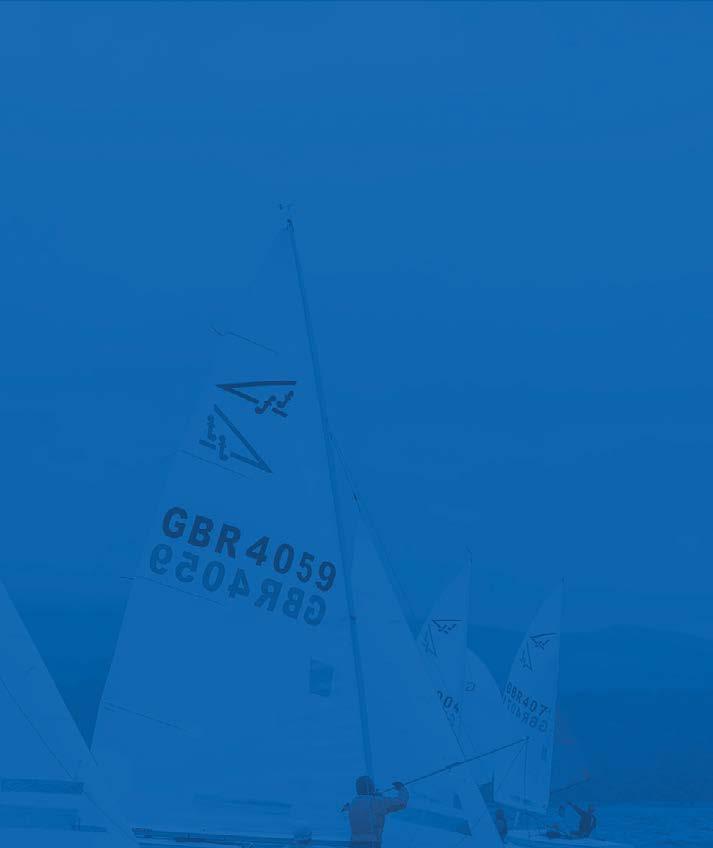
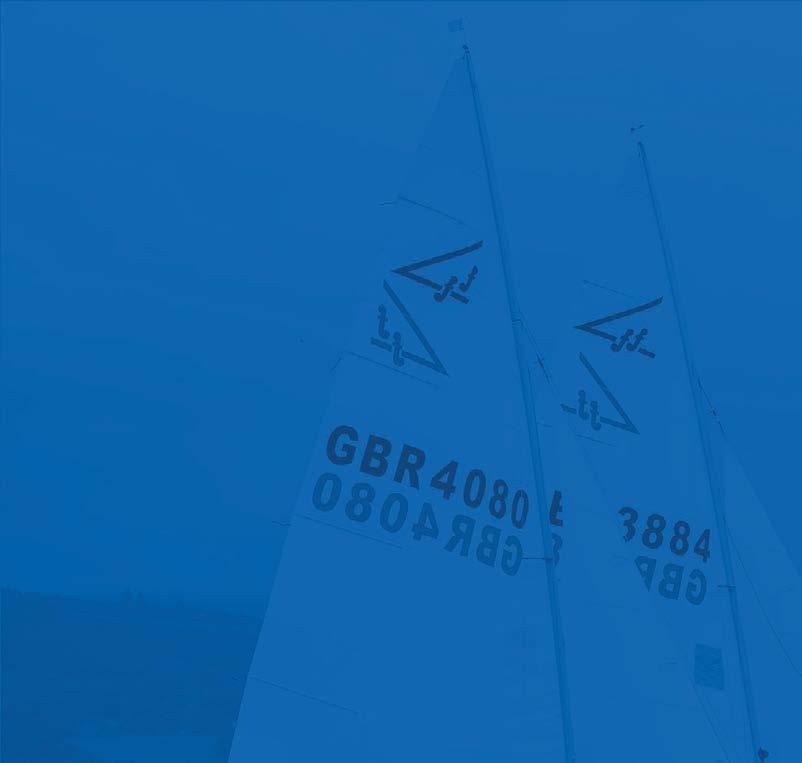
Finally, during 2022 keep thinking of how you could contribute to FF World 2023 in the form of articles and photos. Please remember that we want photos straight of the camera or phone unedited in size otherwise we are unable to offer the visual feast that was the 2020 edition.
Simon Thompson Editor & Webmaster (UKFFA + FFI) GBR4080 Windbreaker (wet end!)
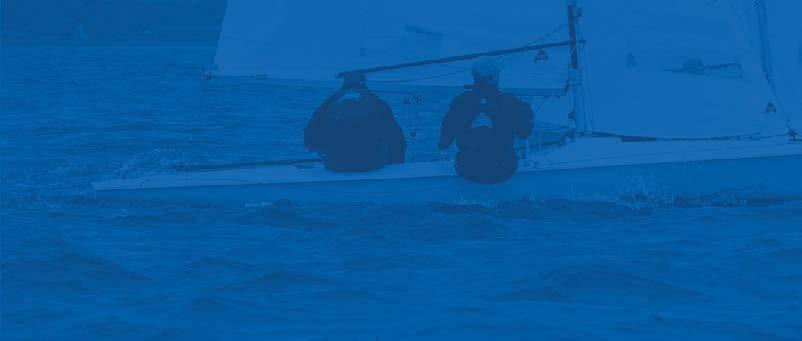
Contents
Front cover photo by Hamo Thornycroft
Editor’s Comments .................................................3 UKFFA President .....................................................4 Secretary’s Scribbles 5 Chris Wapples - FFI Commodore ...........................6 National Championships 2021 Report ...................8 Cruising a Flying 15 for Fun .................................12 FF 2023 Worlds in Perth Preview 14 Ginger Boats .........................................................15 The Flying Fifteen Jib Revisited ...........................16 Jack Roy Obituary ................................................18 Getting the Measure of Things 19 A home-finished Ovington 10 22 Finishing a Keel at Home......................................24 Flying Fifteens at Cowes 2022 .............................26 Hong Kong Flying Fifteens 28 2021/2 Australian Nationals 29 Conamara Flying Fifteens.....................................34 FLYING FIFTEEN WORLD — FEBRUARY 2022 3
UKFFA PRESIDENT
Well, thanks to you all, we’ve made it through a complete season of Nationals, Inlands, Northerns, Scottish, Southerns, a great open season, a fun set of regatta weeks and the bedrock of the class, club racing. I hope you found something during this programme to get you back out on the water and enjoying the shear delights of sailing and of course, the joy of sailing the Flying 15.
2022 is a qualifying year for the 2023 Australian worlds in Perth, surely a bucket list venue. This means there is a set of qualifying events commencing with the Northerns at Royal Windemere in April and finishing with the Nationals in July. A full set of rules are published here:
https://www.flying15.org.uk/fixtures-and-results/fixture-list/ world-championships-qualifier-series
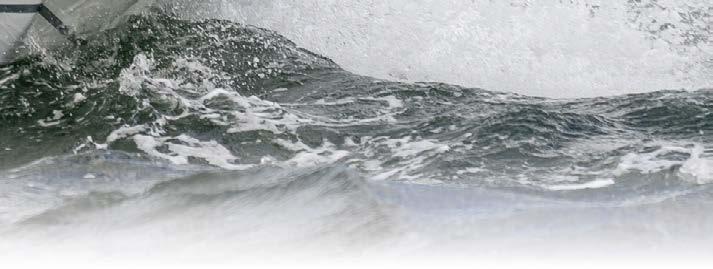
Can I thank Bill Chard for his work in pulling this together. Also, to try and encourage turn outs and increase competition throughout the fleet we will be running 3 divisions at each event with separate prizes.
At the end of the qualification series we plan to notify competitors of their place in the UK worlds team in late July / August. Keith Jamieson has made contact with the shipping agent Pindar and boats will be shipped in late November / December.
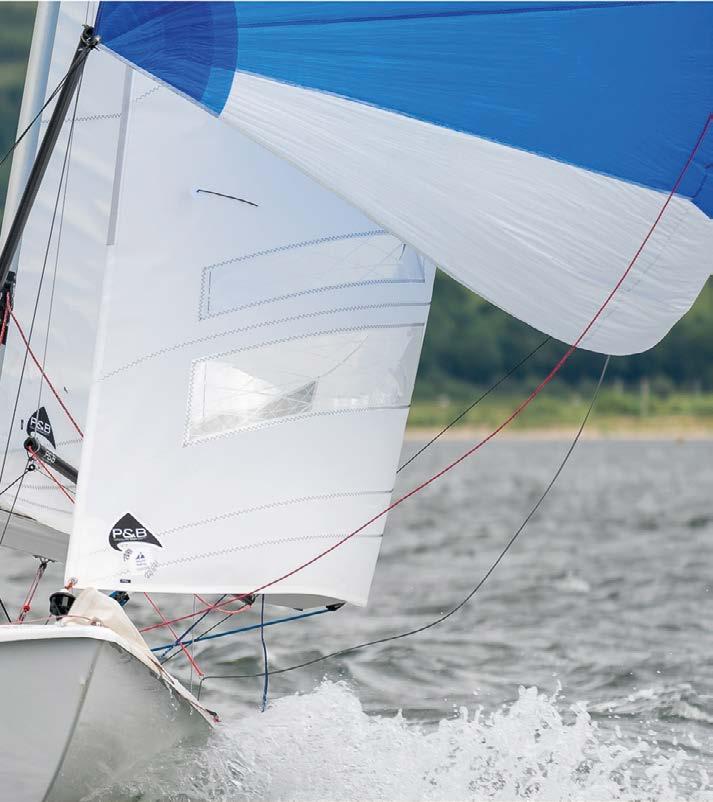

We plan to hold a series of squad training days on the sea during the Autumn to ensure we arrive ‘down under’ fully prepared for 15-20 knot breezes, sunshine and waves. If only the cricketers had done this!
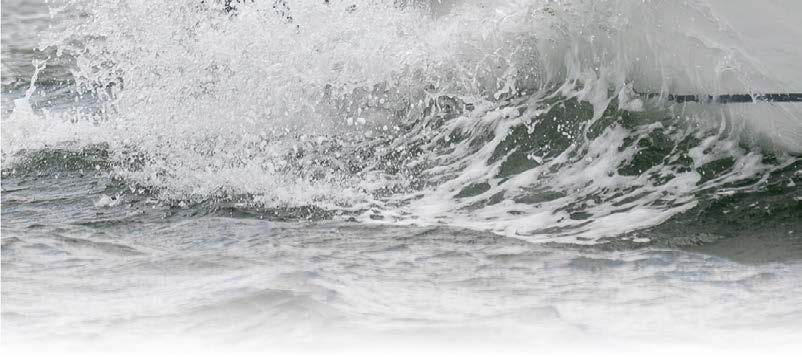
We are still awaiting word from Flying Fifteen International on how to implement the rule changes, especially the weight reduction. We understand the rules are still with World Sailing awaiting ratification. In the meantime, please do not make any changes to your boat.
In addition to the world qualifiers and Nationals at Hayling, there’s also the 2022 European Championships and the class’ 75th anniversary in Cowes in late August. As many of you are aware, there’s a very strong connection between Cowes, the home of Uffa Fox and the Flying 15. This shows through with the European socials at the Royal Yacht Squadron and the Commodores House resplendent with a beautiful wooden Fifteen on a launching crane outside.
Speaking of beautiful boats, the classic nationals will be held at Grafham Water and we’re indebted to Graham Lamond. This builds on the success of last year’s classic open which saw competitors travel from all over the UK including Northern Ireland. Hopefully we can beat last year’s turn out – and who knows, Graham may even compete this time!
One of my winter jobs is to check my trailer bearings and tyres. It’s not difficult to change the bearings – just messy, have a look on YouTube or drop me a mail and it’s time well spent. Just ask Charles Apthorp how his drive home from Rhu last year went and Ian Pinnell did a rapid pit stop on the side of the M8 that Lewis Hamilton would be proud of! Other simple jobs include inspecting the jib and main halyards and the shrouds for wear. You sometimes can’t see what’s happening at the top of the mast and it may save an expensive insurance claim.
Look forward to catching up with you all through the year. My first travelling event is the Ovington inlands in March at Grafham and I hope to see some friendly faces there.
Good sailing
Cad - UKFFA President (Ian Cadwallader GBR 4055)
FLYING FIFTEEN WORLD — FEBRUARY 2022 4
Secretary’s Scribbles r



Or yet another deadline nearly missed, I’m sure there will be some editorial comment inserted here! As Douglas Adams once said, I love a deadline, especially the noise they make as they whistle past! (Ed: I heard that too!)

Yet another year has flown by and we’re all a little older (if not wiser); I think Caddy mentioned prior to a quick zoom (funny how we’re doing this a lot) meeting the other day, that not so long ago we were standing in the dinghy show (at Ally Pally) saying it’ll all be over by mid-summer, and we’ll be back to normal. How wrong can you be! Quite a bit it appears.
Well, we did manage to have some club sailing, a lot as it happened, in 2020; it was great to see Flying Fifteen sailors at the fore front of supporting their clubs by throwing themselves in to organising and participating into the grassroots of our sport. Our clubs have really needed the support of all their members to survive this difficult period and I think clubs benefited from the reduction in championships through increased involvement in club racing; we certainly did at Windermere.
On getting through the difficult period of the last 18months we couldn’t have done this without the support of you, our members. As a member’s association we are funded by your subscriptions, these funds allow us to run the association and present the class as the one to be in. Without you we would not have managed to attract the members we have, put on the championships, run the website, produce newsletters, go to the dinghy show (virtual or in person), produce newsletters, and develop the annual magazine. The UK association also contributes significantly to the funding of Flying Fifteen International, we contribute over 50% of the international association’s funds far more than any other nation. So, you can be proud to think that your small contribution, so for the price of a reasonable meal and a couple of beers you have a truly global reach. What they do with the money of course is another matter! We have generally managed to maintain our membership levels without too many losses beyond those who have retired from the class or moved on.
Without championships in 2020 you’d think that there was very little going on in the world of Flying Fifteen’s but there was in fact a great deal of interest in the class from new members. Over the 2020 and 2021 seasons we have attracted a fair number of new members and we are welcoming old friends back into the class. At the time of writing the Aldeburgh fleet is back on the up and there is a new fleet emerging at Brading Haven on the Isle of Wight; we have also seen interest in the class from notable Dragon and Squib sailors all buying boats and joining in the fun. We managed to build 9 new boats in 2020, 5 for the UK 3 in Ireland and 1 in Australia.
We saw a welcome return to championship sailing in 2021 and we were able to run a full programme for the year. The running of these events was a challenge for all involved as various restrictions on gathering were still in place in various locations, but we
persevered and were rewarded by good entry levels. These have been challenging times for many, many people for a variety of different reasons. There were a few notable absences but all of us understand that everyone’s circumstances and priorities are different, so we thank those for turning up and look forward to welcoming familiar faces back in 2022. We will of course miss those of our class who are no longer with us, and I shall miss two stalwarts of the fleet Peter Clark and Andy Goddard, who I am pleased to have known through the family of Flying Fifteen Sailors. Both have supported the class directly and indirectly and that is greatly appreciated, they both will be missed from the fleet.
We did try some new ideas for encouraging wider participation in 2021, particularly to encourage older boats to travel to organised events. Some of these ideas have been a success and some have not, safe to say we are carrying forward the ideas that have worked. We again managed to build another 8 boats for 2021 with 6 in the UK and 3 in Ireland, Ireland really punching above their weight in terms of new boats per flying fifteens in the general population. We have also welcomed a new builder to the class in Ginger Boats (building from Brett Dingwall’s mould) and look forward to seeing how their boats go in the new season, early results are promising. In fact, acquiring a Flying Fifteen appears to be a little difficult right now and Ovington boats order book is, I understand, full; having welcomed so many new people into the class the secondhand list is rather bare also. So, if you have a Flying Fifteen not used that much (can’t think why) and are looking to sell then now is a good time to advertise.
I’m sure you will have seen elsewhere in these pages’ communications from our new Class President, Caddy, and the work of our new Vice President Bill on the world qualifiers. I am really pleased to be able to report that we have good replacements for past offi cers on our committee and those who have been involved for a while are remaining. We are benefitting from input in several areas including Jeremy on electronic newsletters & publicity, Graham & Jordan on classics and silver fleet boats, Simon on the website, newsletters & publicity, Bobby on trophies and Tim as FFI Councilor. We of course owe a huge dept to Mike Kilbee for organising our championships, a replacement for whom we hope to announce soon.



We have a full programme planned in for 2022, with a few spaces left for some open meetings, and the season will build nicely towards the worlds in Australia. So, if you’re thinking of going look out for the NOR and get your entries in to the qualifiers as you will benefit from sailing in the larger competitive fleets to be seen at these events. 2022 is looking like it’s going to be a good year for Flying Fifteen sailing, and I really look forward to sharing a beer with some old friends and new at an event near you.
Best Wishes, good sailing, and fair winds.
Keith General Secretary UKFFA
FLYING FIFTEEN WORLD — FEBRUARY 2022 5
This is my first newsletter since becoming FFI Commodore. For those that don’t know me, I’m Chris Waples and have been sailing a Flying Fifteen for the past 10 years, mainly at Hayling Island.
2022 will be the year we celebrate the 75th anniversary of the Flying Fifteen. We are eagerly looking forward to a big fleet in Cowes in August, with the Cowes Corinthian Yacht Club hosting the European Championships.
I would like to update you on a few initiatives from FFI to continue to support the development and growth of the class. Since becoming Commodore in May 2021, it has become very evident the class across all countries has two distinct groups of sailors. Those that like the competitive racing circuit and a backbone of club sailors that enjoy local racing; the latter group account for approximately 75% of all members.
The most common question I get asked is “how can we grow the class”. We are not alone, sailing clubs and classes are all seeking the magic ingredient to attract new members.
I believe, the fundamental issue we face is the lack of quality used boats to meet the demand for people wanting to join the class. You only have to look how quickly used boats are sold to see the issue. With only an average of 10 new boats a year over recent years, it limits the number of boats flowing into the used market. Realistically we need to have 30-40 new boats across all
Chris Waples
countries to make a difference. I therefore encourage new builders to stimulate new boat production and choice.
There is a need for those at the top of the fleet to nurture the club sailors and demystify the art of setting up of the Flying Fifteen. There are great examples of members helping others achieve quick wins and improve performance, and make the boat easier and more enjoyable to sail.
To help this process FFI will be producing a series of short videos, accessible across a variety of social media platforms during 2022. Please support this initiative if you are asked to help.
Media coverage is a great way of showcasing the class from a racing and social perspective, I encourage you all to send your reports, stories and pictures through to Jonny Fullerton at the email address reports@flying15.org.
FFI have a role to keep the Class current and make incremental changes. You may have seen the recent ballot with a number of rule and constitutional changes. As a result of the improved communication with members and on-line ballot voting, I was delighted to see participation increased by 25% compared to the 2019 ballot.
Finally, there are plenty of sailing events planned for 2022 to celebrate the 75th anniversary. In 2023, the World Championships with be held in Perth, Australia.
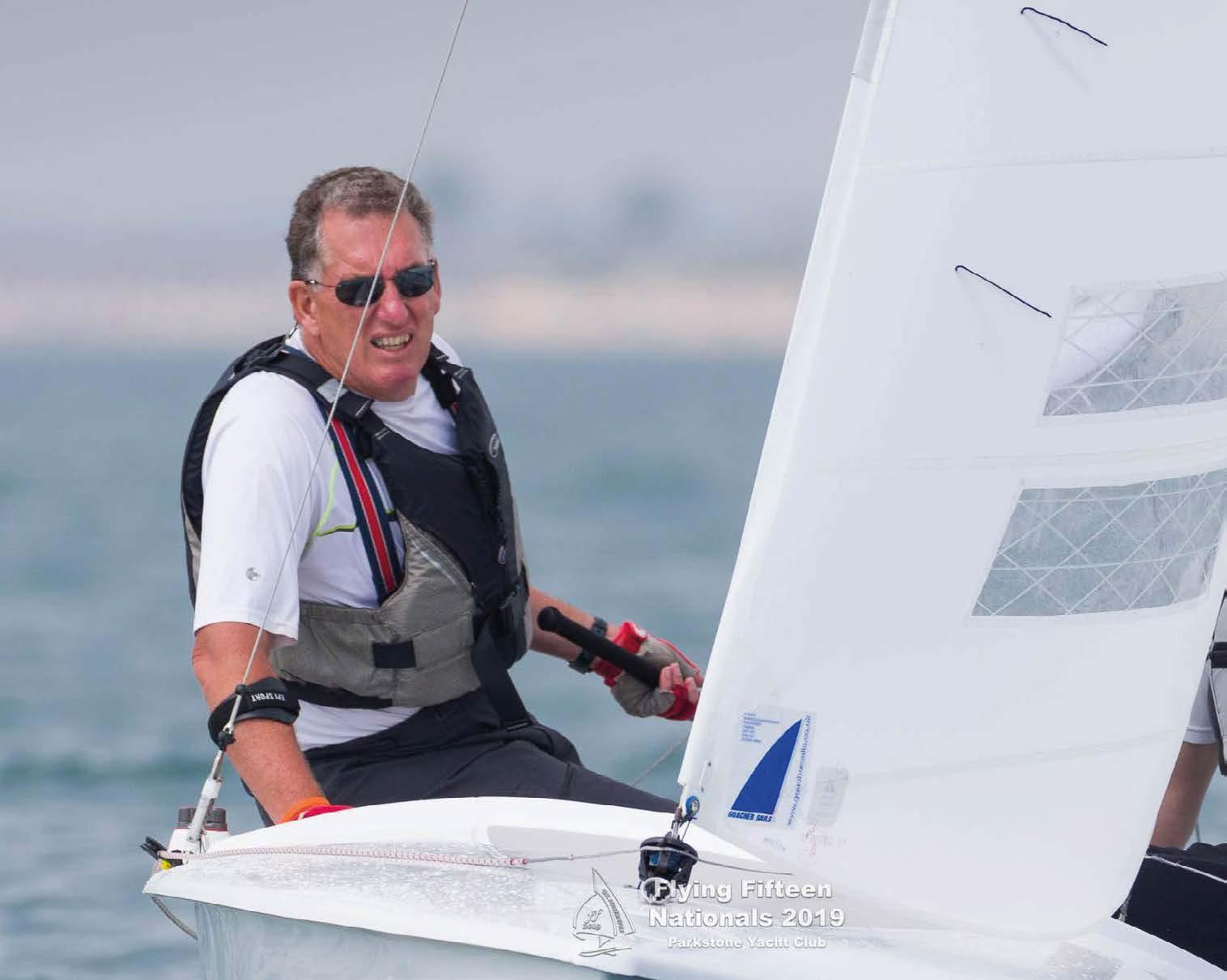
Commodore FLYING FIFTEEN WORLD — FEBRUARY 2022 6
FFI




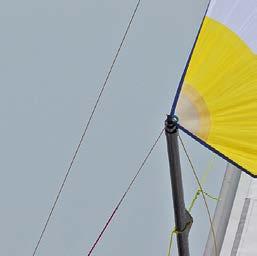



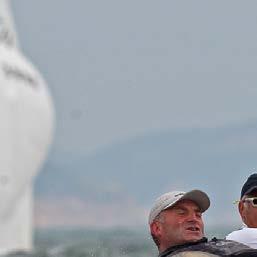

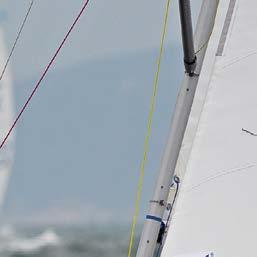
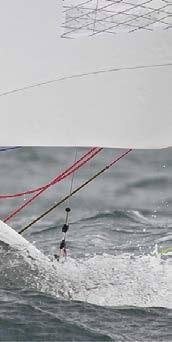
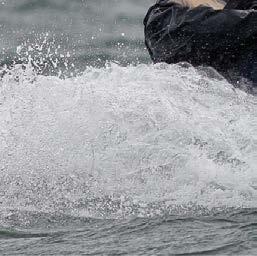









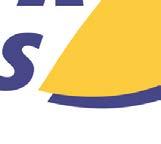






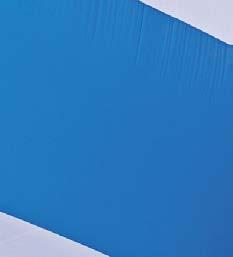

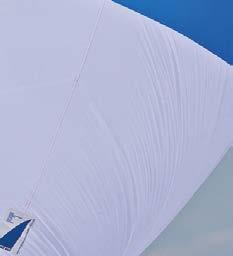
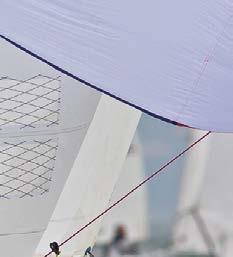
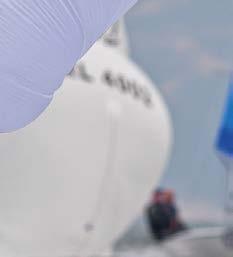

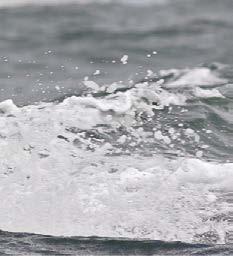
FLYING FIFTEEN WORLD — FEBRUARY 2022 7 OVER 30 YEARS OF SUCCESS •SAILS •COVERS•ACCESSORIES •ADVICE DESIGNED FOR PERFORMANCE, BUILT TO LAST - 6 World Championships - 5 European Championships - 16 UK National Championships 00 44 (0)15394 88686 LOFT@GOACHERSAILS.CO.UK WWW.GOACHERSAILS.CO.UK OVER 30 YEARS OF SUCCESS •SAILS •COVERS•ACCESSORIES •ADVICE DESIGNED FOR PERFORMANCE, BUILT TO LAST - 6 World Championships - 5 European Championships - 16 UK National Championships 00 44 (0)15394 88686 LOFT@GOACHERSAILS.CO.UK WWW.GOACHERSAILS.CO.UK
UK Global Flying 15 National Championships
RHU, 24TH - 27TH JUNE 2021
The fleet assembled for its first national championships since Parkstone in 2019.
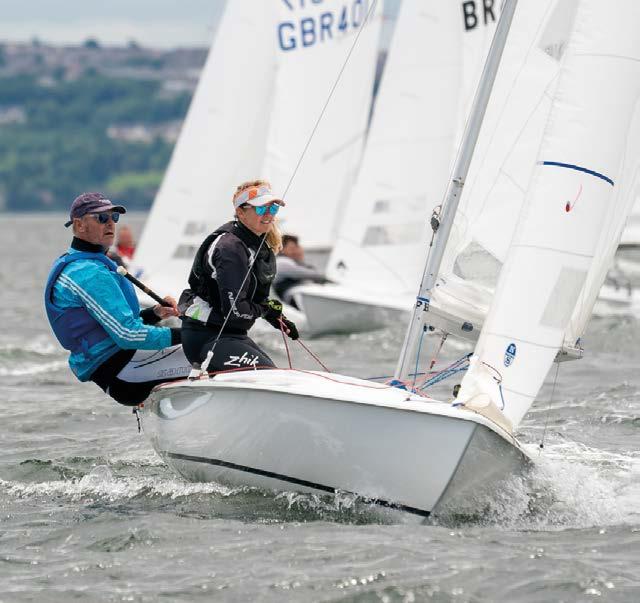

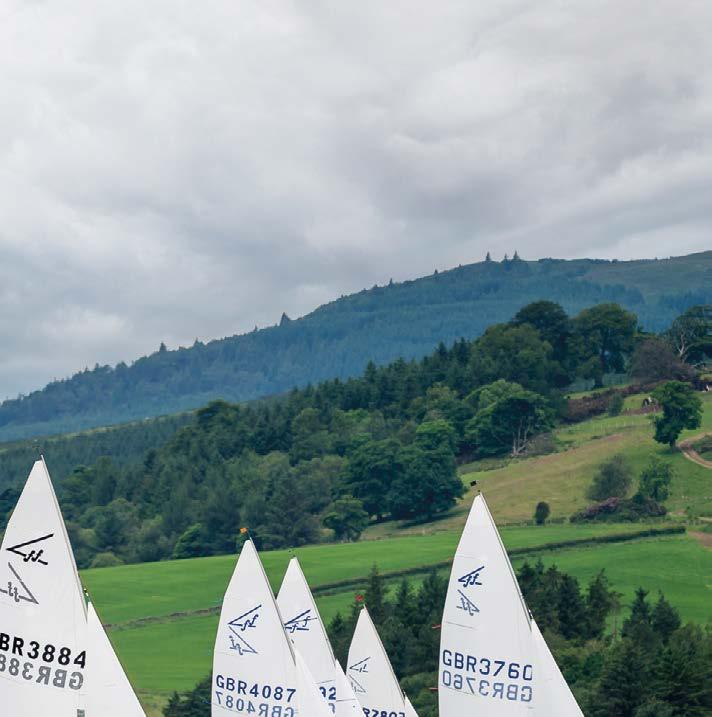
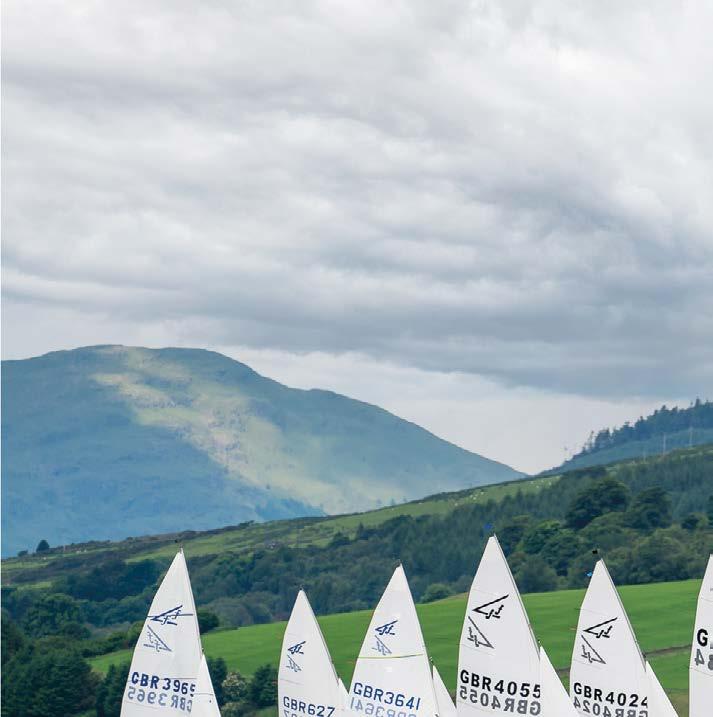
Due to Covid and location the fleet size was only 33 boats, including a good contingent of Classic boats.
This was a new location at Rhu with the event being based in the marina and being wet sailed, which made for a favourable contrast between this event and the last time the fleet was here in 2015 when there was a longer sail back into the Gare loch and to the small steep jetty at Blairvadach.
The forecast for the event favoured the light wind specialists, with Friday being the windiest (and wettest) day. The courses for both races on day 1 were 2 laps windward leeward.
DAY 1
Racing commenced at 12:55pm with the wind coming from the southwest with a variability of about 20 degrees. The committee boat unexpectedly showed no bearing to the windward mark, so the fleet had to decide on the way to windward with the fleet splitting between those choosing a middle course up to windward and those deciding to go hard left - which proved to be the correct decision.
The first boat to the windward mark was 4092 sailed by newcomer to the fleet Nigel Biggs from Budworth Sailing Club near Northwich. Nigel comes from a big boat background and his tidal understanding paid off. The second beat changed the positions around and at the finish Greg Wells and David Tulloch (4030) led from the Ian’s - Pinnell and Cadwallader (4055) with current world champions Graham Vials and Chris Turner (4071) in third place.
Race 2 of day 1 started in similar conditions but the fleet was now over excited and had to be subjected to a General Recall. The second start was more acceptable but proved a bit messy in the middle order with much jockeying for clear air going away from the line. The tide had now turned and was starting to ebb quite fast, and the wind played games and delivered some quieter moments when the larger crews had to “hide” inside the boat. Going left was still the right decision and the surprise first boat at the windward mark was Mike Preston and Chris Robinson from Blackpool and Fleetwood YC. The change in tidal conditions and wind strength conditions for lap 2 saw changes in position and by the end Graham Vials and Chris Turner had returned to their winning ways followed by Jeremy Davy and Martin Huett from Draycote Water SC with the Ian’s in third place.
Overnight positions were Vials/Turner first, the Ian’s second and Wells/Tulloch third.
FLYING FIFTEEN WORLD — FEBRUARY 2022 8
DAY 2
Friday’s forecast was for lighter winds from the north but no rain. That proved to be half true; no rain but F4-5 winds which in Helensburgh means over the hills and with 40 degree wind shifts, which proved to be a challenge for the whole fleet.
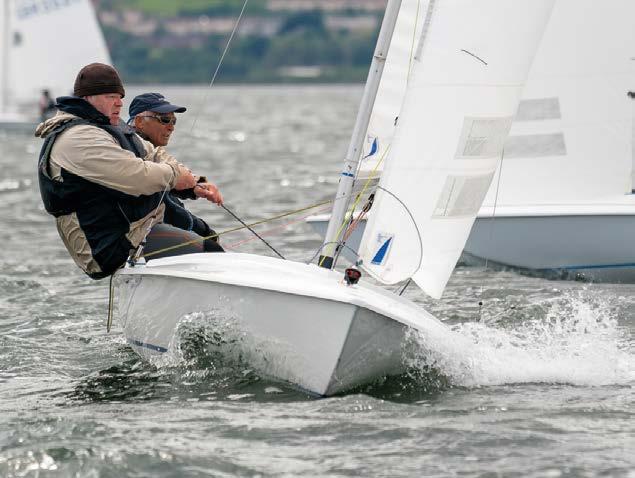

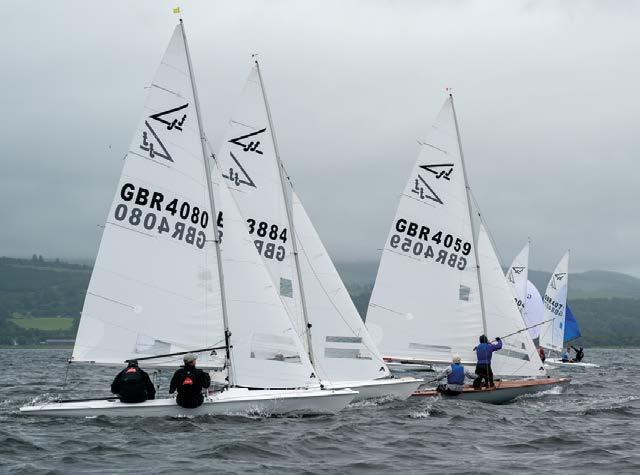
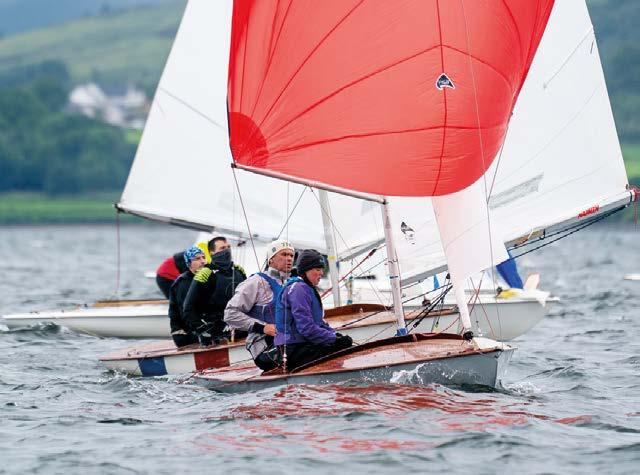
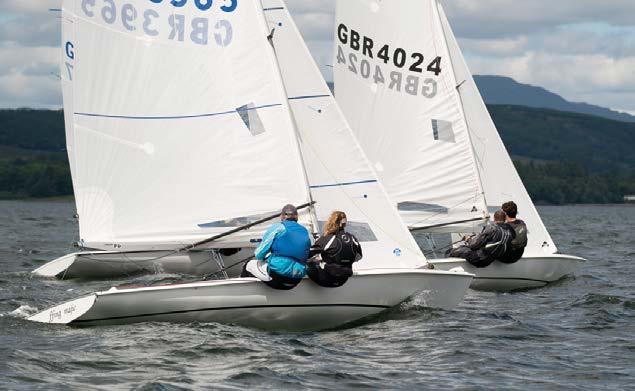
Race 3 was a 3-lap windward-leeward affair made interesting by a wind shift to port at the start making getting away from the line difficult for many boats. Those choosing a pin end start and tacking onto port ultimately benefited. The first windward mark was very busy as the fleet arrived “en masse” and there were a few issues to be resolved between teams. The expert of shifty conditions, Steve Goacher and Tim Harper made the best of the race to win from Davy and Huett. Vials and turner took the third place.
Race 4 was the first with reaching legs, again 3 laps. The fleet was now used to the days conditions and made a better job of the approach to the windward mark with many of the leaders going hard left in the approach to the windward mark. The off-wind leg was characterised by bands of winds down the run; something that every race on day 2 featured, so choice of the route downwind was crucial to maintaining position come the following beat. Race 4 ended up a win for Nathan Batchelor and Richard Rigg with Day/Huett and Vials/Turner taking the runner up slots.
The Race Officer took his time setting the course for the final race of the day before settling on a small 10 degree adjustment to post.
Race 5 (again with reaching legs, 3 laps) started with yet another wind shift occurring just after the start causing the fleet to change onto port tack for the first half of the beat before going for the windward mark. The wind was reaching its maximum at this time and all enjoyed brisk runs down to the leeward mark. The reach was not a challenge being set quite flat but still gave the opportunity for overtaking in the gusts downwind. at the end of the race there were two teams way in front; Goacher/ Harper and Vials/Turner with Steve Goacher just missing on the line honours.
After 5 races over 2 days, Vials/Turner had a 3 point lead over Davy/Huett, with Wells/Tulloch another point adrift and similarly with Goacher/Harper.
FLYING FIFTEEN WORLD — FEBRUARY 2022 9
DAYS 3 & 4
The forecast was not promising for the last two days of racing, and it proved correct. Both days of racing were abandoned as un-sailable due to lack of wind.
Some competitors even anticipated the decision for Sunday by hauling their boats out on the Saturday.
The event was therefore decided over 5 races ensuring 1 discard in the results.
The 2021 UK Global Flying 15 National Champions were Graham Vials and Chris Turner (1,3,3,1) leading from Jeremy Davy and Martin Huett (2,2,2,5) who were just one point ahead of Greg Wells and David Tulloch (1,4,4,3).
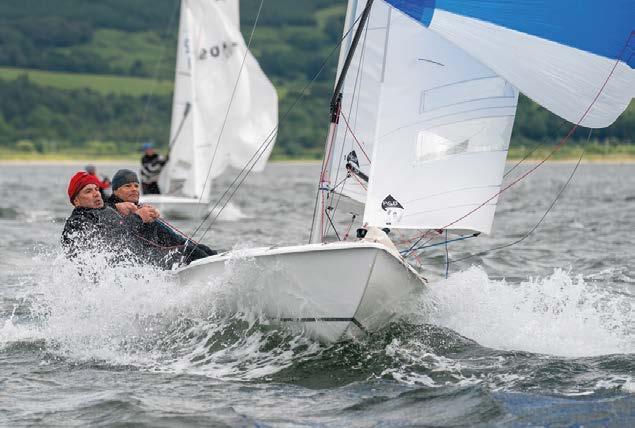
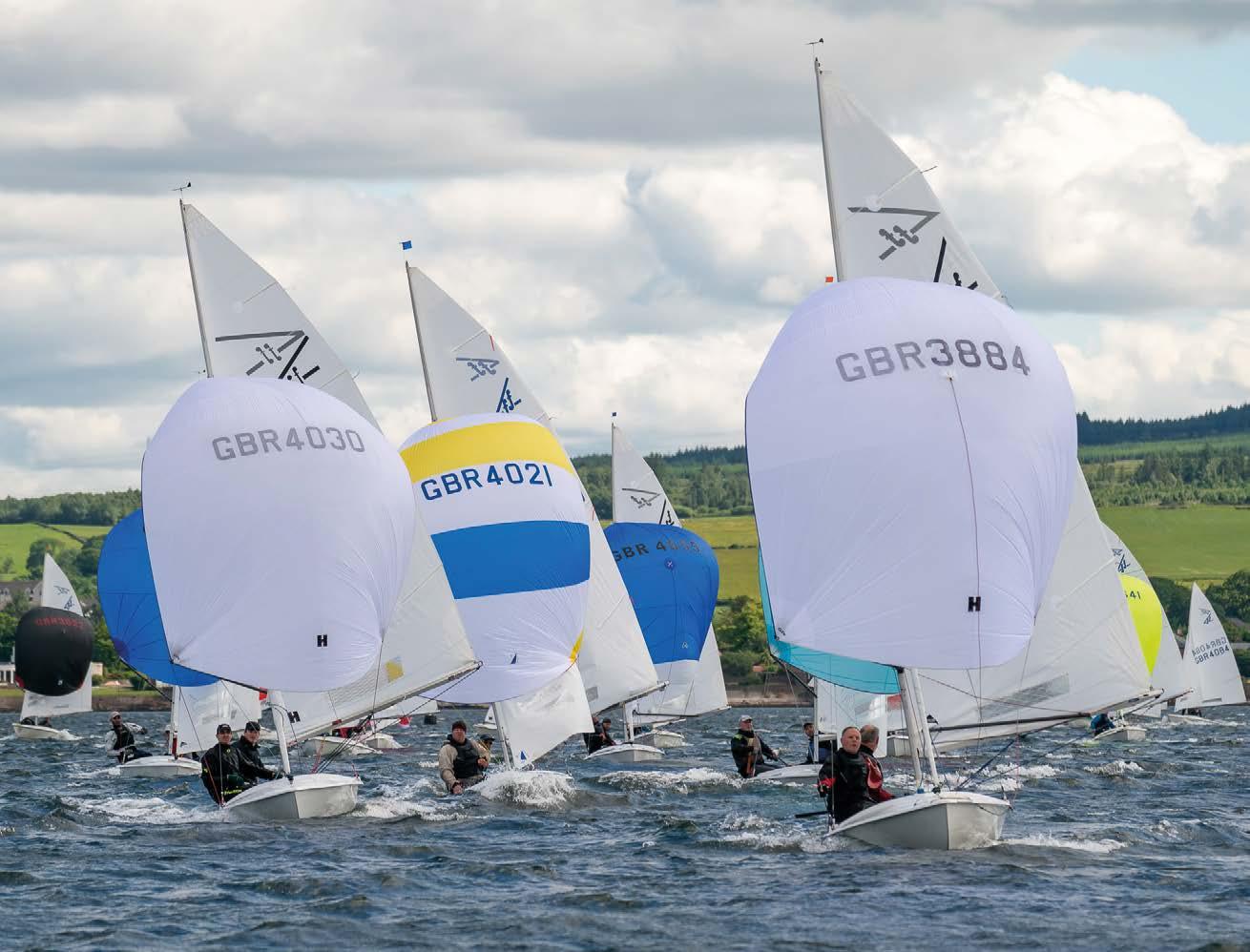
Jeremy and Martin also won the prize for the first helm and crew with a combined age of 100+, to their evident delight! I am sure that Steve Goacher was happy to hand this prize over to someone else.
The Silver Fleet championship was taken by John Hanson and Helen Selden in FF2260 Forever Fish.
The prize for the first lady was won by Jackie McKellar crewing for Justin Waples.
Results can be seen at:
https://www.halsail.com/Result/Public/54908
Report by Simon Thompson (GBR4080 Windbreaker)
All Images used in this article are courtesy of Neill Ross. For more images and for picture sales visit: https://www.neillrossphoto.co.uk/regattas or contact Neill on neill@neillross.co.uk
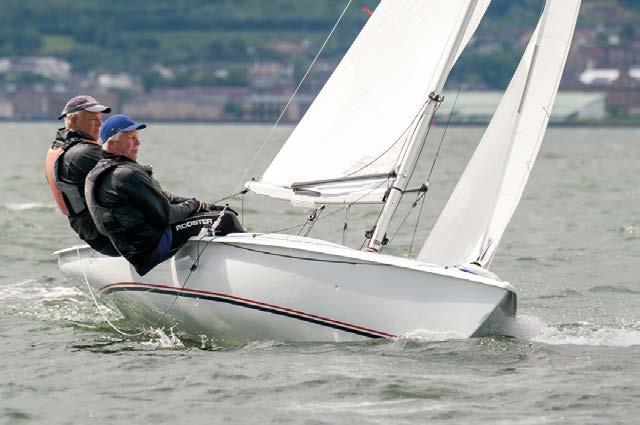
FLYING FIFTEEN WORLD — FEBRUARY 2022 10
Results from Royal Northern and
Class: ‘Flying Fifteen’
Clyde
Yacht Club
Series: ‘Flying Fifteen British Isles & Classic National Championships’




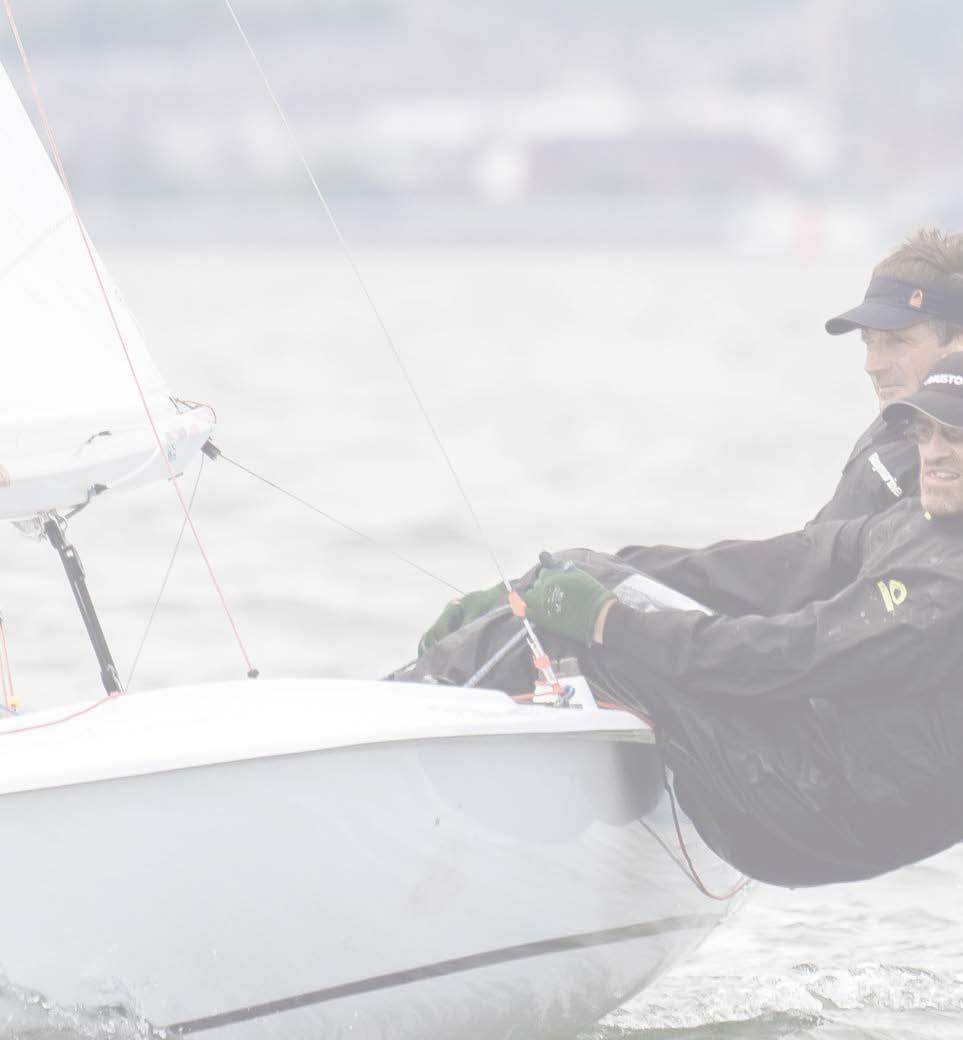

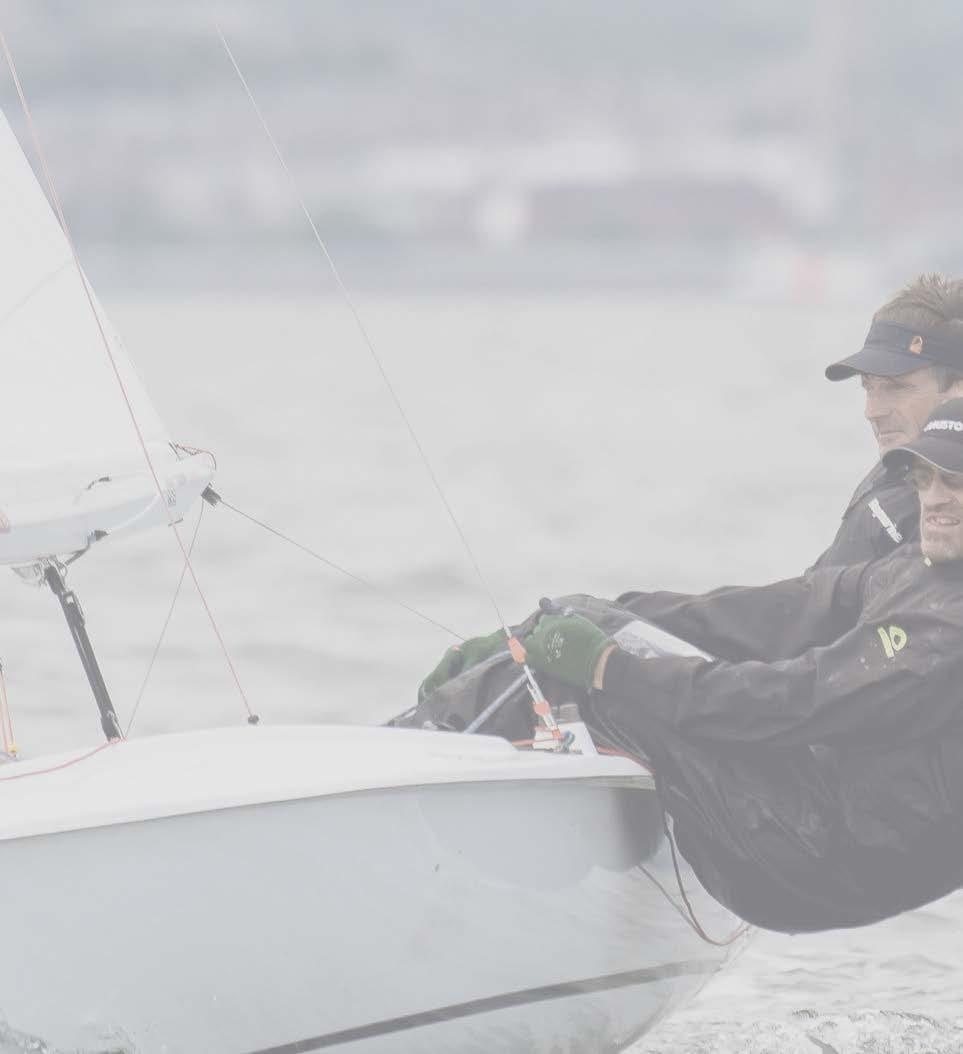
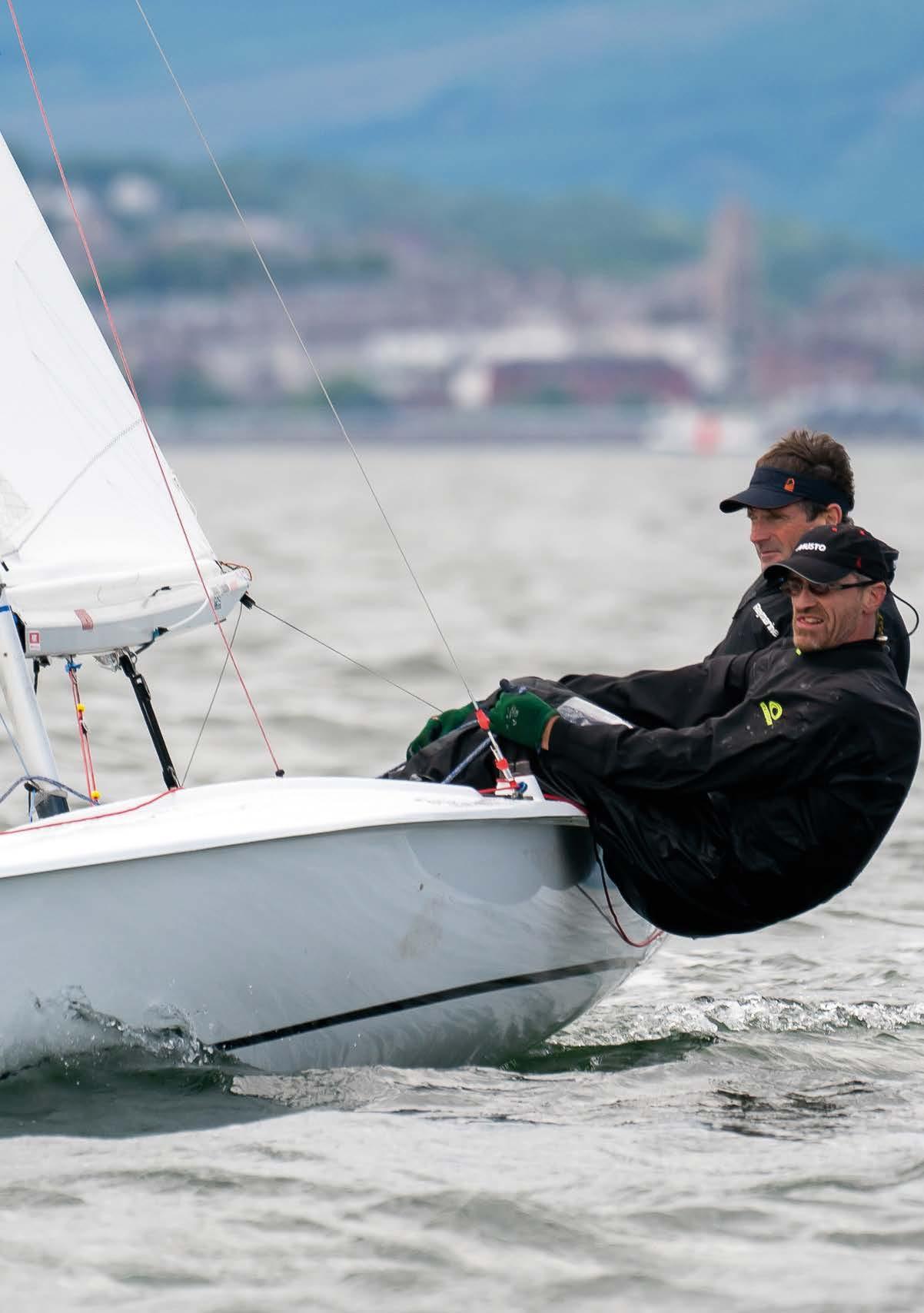
Rank Sail Number Selectors Name Helm Crew Race 1 Race 2 Race 3 Race 4 Race 5 Net Pts 1 GBR4071 Floaty McFloat Face Graham Vials Chris Turner (3) 1 3 3 1 8 2 GBR3760 Jeremy Davy Martin Huett (8) 2 2 2 5 11 3 GBR4030 Agatha Greg Wells David Tulloch 1 (5) 4 4 3 12 4 GBR4021 The Whippet and the Whopper Steve Goacher Tim Harper 5 (13) 1 5 2 13 5 GBR4055 Ian Pinnell Ian Cadwalader 2 3 (11) 6 7 18 6 GBR3942 Nathan Batchelor Richard Rigg (18) 4 9 1 8 22 7 4087 Andy Tuncliffe Kevan Gibb 7 6 13 (18) 6 32 8 FF4004 Foof Charles Apthorp Charlie Apthorp 6 16 (29) 8 4 34 9 4092 Checkmate XIX Nigel Biggs Peter Evans 4 15 8 7 (16) 34 10 4033 Sparks & Bubbles Justin Waples Jackie McKellar 12 9 5 (14) 14 40 11 3641 ffunky Chicken Mike Preston Chris Robinson 17 7 6 (34/ DSQ) 10 40 12 GBR3862 Havoc Alastair Stevenson David Culpan 11 (14) 7 9 13 40 13 4024 Really Flying Simon Kneller Ben Longstaff 13 8 10 10 (15) 41 14 3965 Ffin Magic Simon Childs Kato Greer (14) 10 12 11 9 42 15 4017 Carbon Footprint Phil Snewin Chris Ducker 9 12 15 16 (20) 52 16 GBR4080 Windbreaker Simon Patterson Simon Thompson 16 (20) 19 12 12 59 17 3520 Chips for Free John Reekie Rory Yardley (22) 17 14 20 11 62 18 GBR3884 Flossie Mark Nicholson Steve Culpitt 10 11 (34/ RET) 17 26 64 19 4013 More Mischieff Chris Bowen Marion Bowen (25) 21 17 13 21 72 20 3622 Foo Fighter Robert Mountain 21 (22) 16 19 19 75 21 4059 Panda Hamish Mackay Sally Mackay 15 18 23 22 (24) 78 22 GBR4046 Fram Freyr Richard Drabbie Matt Pallett 20 19 (22) 21 18 78 23 GBR2260 2 Forever Fish John Hanson HelenSelden 23 23 20 (25) 17 83 24 3463 Firth of Fifth John Thornley Megan Thornley (28) 25 18 24 23 90 25 4084 Ineffable Tim O'Brien Sam Neal (30) 29 27 15 22 93 26 627 2 Vamoose Bobby Salmond David Cunningham 19 (34/ DNS) 21 23 34/ DNC 97 27 3590 Frequent Flyer Charlie McKee Simon Montague 27 24 25 26 (28) 102 28 GBR3906 Maverick Peter Mountain David Guite 26 (30) 26 28 25 105 29 GBR3074 1 Ragamuffin Alasdair Ireland Alasdair Ireland Jr 29 26 24 27 (34/ DNC) 106 30 3732 ffootloose Ian Hockey Valerie Hockey 24 31 (34/ RET) 30 27 112 31 3142 1 John Best Iain Best 32 27 28 29 (34/ DNC) 116 32 2803 1 Ffeeling Lucky Glen Fullarton Craig McCracken 31 28 30 31 (34/ DNC) 120 33 3451 1 Whipsnade Hugh Simpson David Watkins 33 32 31 (34/ DNF) 34/ DNC 130 Crew 11 3 12 4 Whopper (13) 1 13 5 18 6 Richard Rigg (18) 4 9 22 7 Kevan 6 (18) 32 8 FF4004 34 9 Checkmate Peter 8 34 4033 & Bubbles McKellar 12 9 5 (14) 40 3641 Chicken Chris 17 7 6 40 Flying 41 42 Snewin 52 Simon Thompson 16 12 59 Chips Rory (22) 20 62 10 72 Fighter Robert 75 Mackay 78 78 Forever 23 83 of Fifth John Thornley Megan Thornley (28) 24 90 Tim (30) 15 93 Bobby ham 19 Ireland 31 33
SELECTOR MEANINGS 0 - OPEN 1 - SILVER 2 - CLASSIC FLYING FIFTEEN WORLD — FEBRUARY 2022 11
Cruising a Flying 15 for fun!!


Gone are the days when our club sported some 30 Flying Fifteens. Now there are but 3 left here in Torquay. The other 2 boats rarely venture out, so we are left to our own devices. Ariane, number 3567 is our 3rd Flying Fifteen, and we put to the water simply for the joy of sailing this fine class of sailing boat.
Most of the time we confine our excursions to Torbay where we sail safely in winds up to about a force 6. We had some fine sailing in the Carrick Roads in 3219, but rarely stray that far these days. Torbay is shaped such that we feel perfectly safe in such winds up to a 6 - at least in summertime - often when no one else is out. This January we have had some spectacular sails. Occasionally we leave the Bay to sail to Ansteys Cove or Babbacombe Bay or stray further out to some cardinal buoys marking a wreck a few miles offshore.
Our favourite trip is to go south to Dartmouth, some 11-12 nautical miles down the coast (by the direct route). This is more demanding and so we go to Berry Head at the southern arm of the Bay and take a look down the coast to check the sea state. More than once, we have taken quite large waves inboard: an indication that a visit to Dartmouth that day is too ambitious. Our favourite condition is a south/southwest breeze up to force 5. It’s hard work beating down the coast, but the views are spectacular, and we have the promise of a fun return. Turning into the river is usually a challenge with the wind barrelling out of the estuary,
and the last couple of miles past the castle to Royal Dart Yacht Club are quite challenging, with numerous severe wind changes both in terms of direction and strength. A pasty and a pint at the club, and we’re ready for the ride home. This last summer we were rewarded with a freshening wind from the southwest: easily a 5 with quite large waves rolling out of Start Bay. We headed a couple of miles out to sea, gybed, set the spinnaker and hurtled downwind for the 4 miles to Berry Head, due north.
Everyone will know the feeling when the wind strengthens, the boat surges ahead, the bow lifts and you’re off - faster and faster. You hold your breath and sit very still!
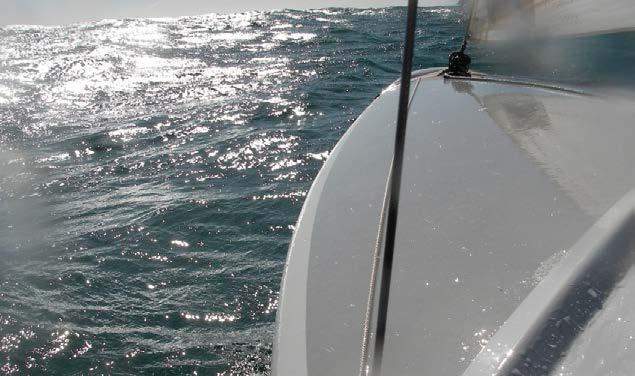


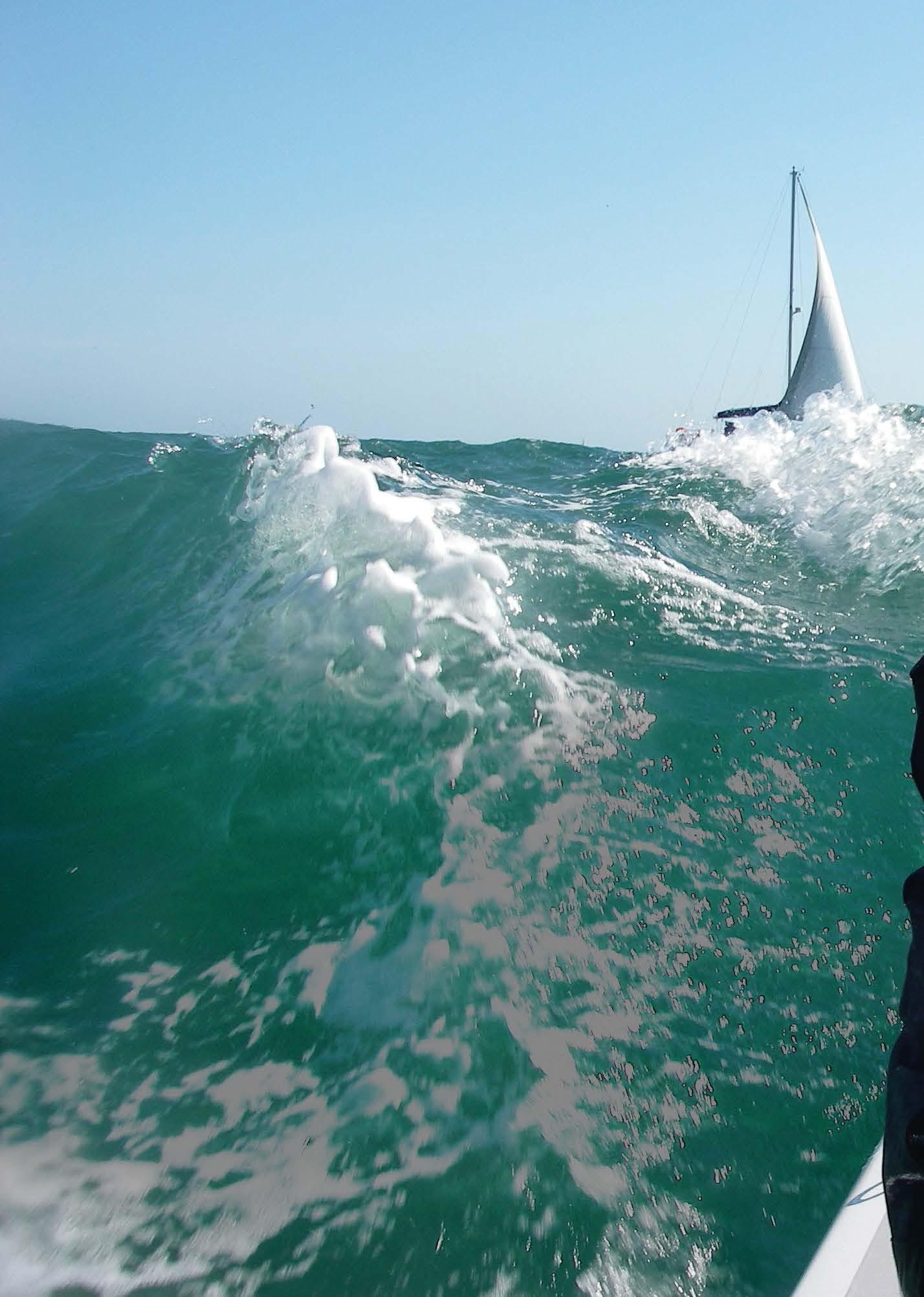
We use the Strava app on our mobile phones and so record our track and speed. I had no idea what to expect, but discovered that on two occasions on the roller coaster ride back to Torbay we nearly touched 30 knots. Once past Berry Head the wind veered and gave us a beam reach back to Torquay. One hour 15 minutes from Dartmouth Castle.
I tell this story to remind fellow Flying Fifteeners there is wonderful sailing experience to be had away from the racecourse. This Class has something for everyone. If you fancy a pint in Dartmouth this summer, give us a call!
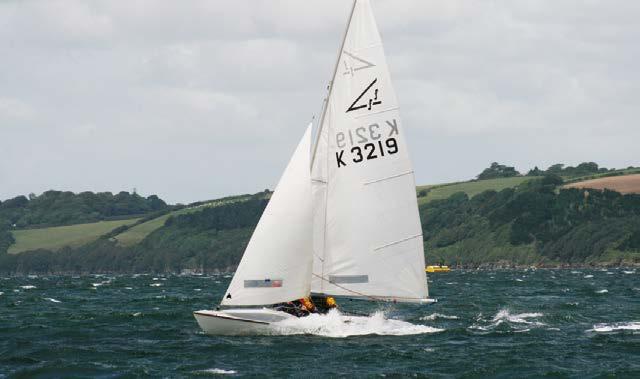 Alan Br kes
Alan Br kes

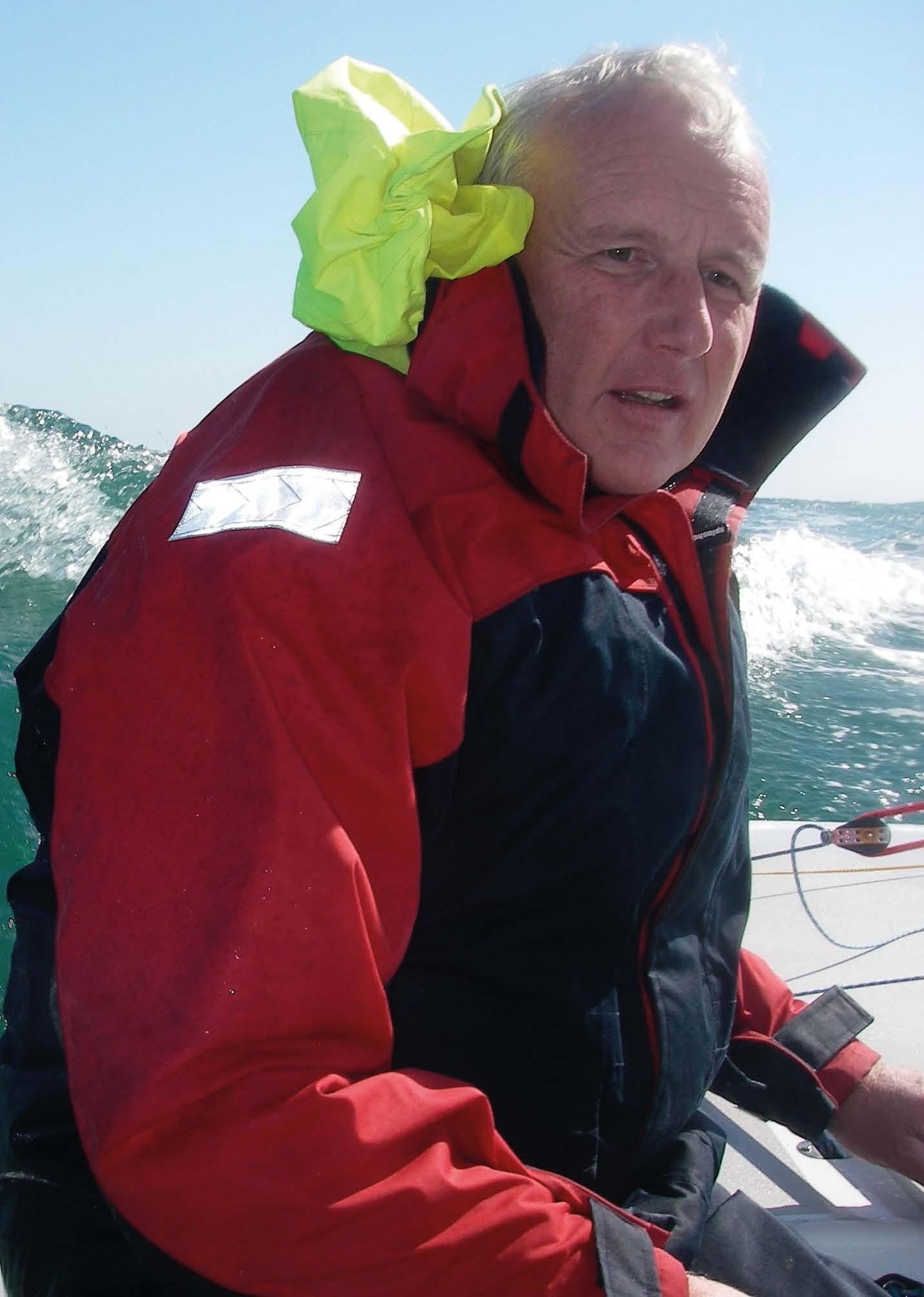
FLYING FIFTEEN WORLD — FEBRUARY 2022 13
“the last couple of miles past the castle to Royal Dart Yacht Club are quite challenging, with numerous severe wind changes both in terms of direction and strength.”
2023 Flying Fifteen World and Australian Championships update
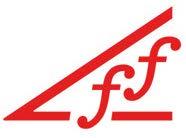
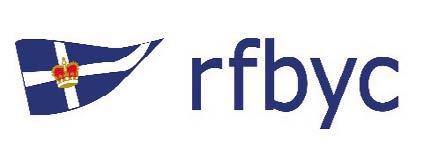
5 Jan 2022
With all the chaos around the World and the COVID 19 pandemic still raging on, I am sure people are wondering what is happening with the World Championship event being held in Australia. I can confirm that the Flying Fifteen World and Australian Championships remain on track and are scheduled to be held between the 9th and 23rd March 2023 as previously notified.
The event was delayed due to the uncertainty surrounding the global COVID 19 pandemic which still continues, and the situation continues to evolve. Australia and in particular Western Australia closed its borders to the rest of the World and as such has been relatively COVID19 free for most of the pandemic. Now the borders are being opened to the rest of the World as the population has reached a high level of vaccination. We expect that Western Australia will open its borders to international visitors on February 5th, 2022, giving the Organising Committee confidence that the World Championship can go ahead in March 2023. The March timetable has been chosen as the weather conditions are generally more forgiving at this time of year.
The event will be sailed out of Fremantle Sailing Club on the pristine waters of Owen Anchorage in the Indian Ocean offshore Fremantle. The facilities at Fremantle Sailing Club are World class and Fremantle is renowned throughout the World for its unique sailing conditions. The proposed course area at Owen Anchorage is a location that has been used for numerous World Championship events, including the Perth 2011 ISAF World
Championships and hosted National and International Sailing events for the Dragon fleet, Etchell’s and 505’s amongst others. Planning for the event is well advanced with jurors and race officers selected, we look forward to welcoming the Wilson brothers to the event as race officers who have conducted many world championships between them. The Organising Committee recognises that at present shipping costs for containerised freight around the World are high, as they are being affected by the results of the OCVID pandemic. It is expected that this will settle down by the time international visitors need to book passage for their boats. The organising authority is working on streamlining the process of shipping boats. Further details can be found on the World Championship webpage on the website: https://www.flying15worlds2022.com
Royal Freshwater Bay Yacht Club with support from South of Perth Yacht Club looks forward to welcoming competitors to Fremantle, and in particular, the many visitors expected from Overseas and the East Coast. This event is well supported by the local government and community so you can rest assured that visitors to Fremantle will be treated to a good show.
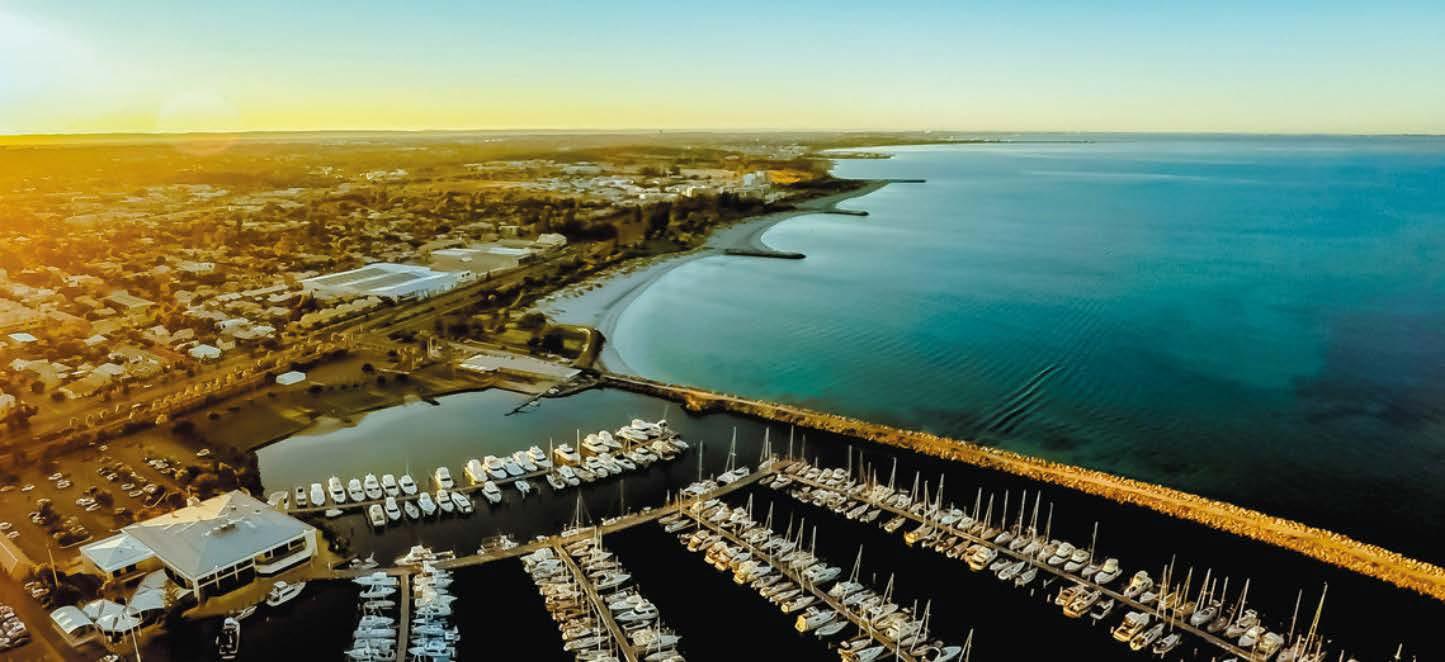
For further information contact:
Humphrey Hale.
Chairman World’s Committee 2023
humphhale@gmail.com
FLYING FIFTEEN WORLD — FEBRUARY 2022 14
Aerial view from Fremantle Sailing Club looking South to Owen Anchorage
GingerBoats
a new builder for International Flying Fifteens
JF: What was the reason for GingerBoats interest in the license to build the F15?
PH: I have always been a fan of the class, there is a good fleet at my local club. A few F15 owners that I know asked if I’d be interested in building F15’s and that Brett’s moulds might be available. It is a fleet I have always wanted to sail in.
JF: What is GingerBoats view of the International Flying Fifteen class at present and your opinions on the future for the class?
PH: The F15 is an excellent international class that’s well supported by its members. It’s also a very competitive fleet with great racing at all levels. Of course, it would be nice to see the class implement a few changes to modernise it, this however needs to be done without removing the core values of the class.
JF: I note that GingerBoats have a lot of experience in wooden boat building, any intentions to build a wooden or composite F15?
PH: For the time being we will stick to building carbon foam sandwich boats. If we are approached to do a wooden decked boat then we may consider it, with everything it all comes down to who is willing to pay for that service. Our hulls will be epoxy carbon foam sandwich, the deck is glass but features carbon in the higher load areas.
JF: What is the approximate timeline for when the first F15 will be completed?

PH: The first three hulls are built with the first boat now on the water for testing ahead of the UK Nationals at the end of June (2021).
JF: How many boats do you anticipate building each year and are GingerBoats intending to export boats overseas?
PH: We’d like to build a couple or more each year, but this will be market driven. We can export if we get the orders.
JF: Are there any plans to modernise the class in any way?
PH: We are bound by the strict rules of the class so there’s very little margin to modernise the boat. We’ve made a few tweaks and changes but many of these are to help us build the boat more efficiently.
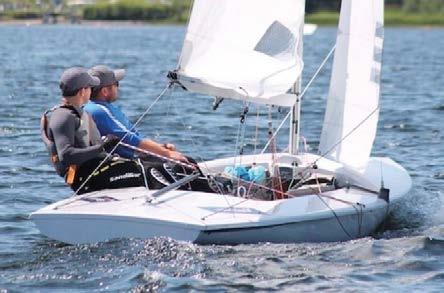
JF: What would GingerBoats like the class to adopt in changes to the current hull, rig and sails to appeal to a wider audience of sailors?
PH: Personally, I’d like to see the class adopt a more modern sail plan, laminated mains possibly. The hull can easily loose a few kg., but I wouldn’t want to create a two-tier fleet. Finding a more cost-effective way to do the keels would help with the spiralling cost of new boats.
JF: Please run through the boat from bow to stern giving an insight into the planned design characteristics or enhancements that GingerBoats intend to adopt?
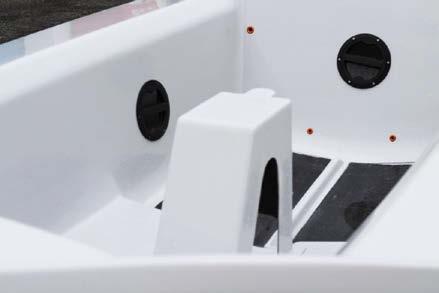
PH: The hull shape has previously had success in the right hands. We haven’t modified the shape and look forward to see how it gets on against the current mk10. Our boats come without a chute as standard but there is an option to have one fitted and we have created all new tooling for this. The lack of chute reduces the weight in the bow.
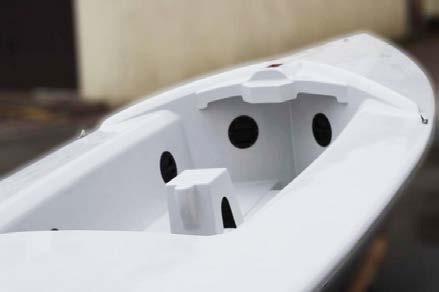
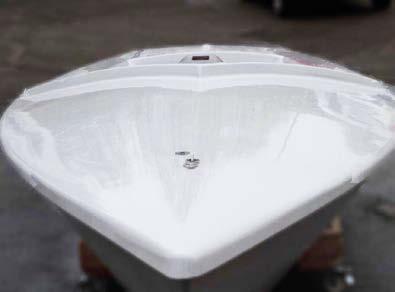
The cockpit area is very open with plenty of space for both helm and crew. We’ve designed a new console to help create even more room whilst being functional and adding our own flare. The fit out is very functional with the controls split evenly between the helm and crew positions. The sail plan we are running with is from Impact Marine, we have been working hard with Andy Tunnicliff e on the sail plan. Andy has taken delivery of boat number 2 from GingerBoats.
Contact Details:
Phil Hodgkins - phil@gingerboats.co.uk

Gingerboats Racing Ltd www.gingerboats.co.uk

FLYING FIFTEEN WORLD — FEBRUARY 2022 15
Jonny Fullerton talks to Phil Hodgkins of GingerBoats on all things Flying Fifteen
The Flying Fifteen Jib Revisited
The new jib entered service in early 2017, following the 2016 FFI ballot. It followed over a decade of staggered development, with different sail designs considered and trialled. The expert view was that the longer luff and shorter foot arrangement offered a modern, crew-friendly, better looking and longer lasting option for the Flying Fifteen class.
Now, with four years’ experience, we asked some of the sail makers and some class experts on whether these goals have been delivered, and what the change has meant for the Flying Fifteen class.
A New Design
The sail area of the jib and genoa are identical – 3.832m2 (41.25 sqft). However, the dimensions are quite different with the jib 300mm longer in the luff, 204mm longer in the leech and 182mm shorter in the foot. This configuration results in a centre of effort slightly farther forward and higher than the genoa. This should mean slightly less weather helm, which may benefit some classic Flying Fifteen designs. Richard Whitworth (North Sails) ran the numbers in North’s sail design software (see accompanying article), finding that the performance difference between the two shapes to be insignificant – within 0.2% of each other!
noted that their main design hadn’t changed with the introduction of the new jib and, as long as the main is in good condition, it would performance equally well with the jib and genoa. Richard Lovering (Hyde Sails) explained that while they had continued to refine the Hyde sail designs, the benefits of having a new jib outweigh an old genoa with an equal vintage main sail. What really matters is the controlling the slot between the main and jib. Steve Goacher (Goacher Sails) explained: “Since the new jib has less main overlap, managing the slot vertically is really important to get the best out of the boat. That will be a little bit different between every boat, but it doesn’t mean a new main is a necessity.”
Replacing the jib halyard
As the new jib’s luff length is 300mm longer than the genoa, the jib halyard needs replacing. This is a straight forward five minute job. The only difficult can be getting the ferrul (swage) through the halyard sheave on the mast. Sometimes this can involve a bit of jiggery-pokery – or in the worst case dropping the mast. If you aren’t ready to part with your genoas, you could switch halyards as needed but the easier way is to purchase a 300mm long wire strop that lengthens the halyard for days when the family cruise warrants the vintage genoa.
Ian Pinnell suggested that replacing the jib halyard is also a good time to check the furler bearings and ensure that the upper swivel isn’t upside-down. When the class first transitioned to the new jib, there were some halyard breakages on boats running 3mm halyard wire. As it transpired, the problem wasn’t the wire but that the upper swivel wasn’t rotating under load. With the furling load now falling on a shorter halyard section between the jib head and mast sheave, the breakages occurred because the halyard wire was being unravelled as the jib was being furled! Most boats are now running a thicker 3.5mm halyard, but furler maintenance is still advised. Charles Apthorp added that it is always a good idea to “unroll the jib against the turn of the wire, which stops it unravelling when it is max loaded.”
Performance isn’t just about straight-line speed. One benefit of the jib over the genoa is that the shorter foot means less sheeting on each tack. In this sense, the jib is a crew-friendly option and, in theory, has lower sheet loads. Richard Lovering (Hyde Sails) stressed that the benefits of lower sheet loads were marginal and many crews would benefit from ratcheted jib blocks: “this allows the crew to ease just a few millimetres – which eases the leech 1-2cm. Even with a strong crew, this level of control is impossible without a ratchet and it is the first thing we upgraded on our boat.”
If you’re sailing a 75 year old design, aesthetics are important and the new jib received a ‘thumbs up’ on this score as well, with its longer leech and rounded foot getting the thumbs up. Several helms also noted the improved visibility behind the jib that represented an important safety improvement as the dreaded genoa ‘blind spot’ is significantly reduced.
A common misconception is that the upgrade to a new jib also requires a new main. Obviously, having two brand new sails is nice, but this needn’t delay the switch. Ian Pinnell (Pinnell & Bax)
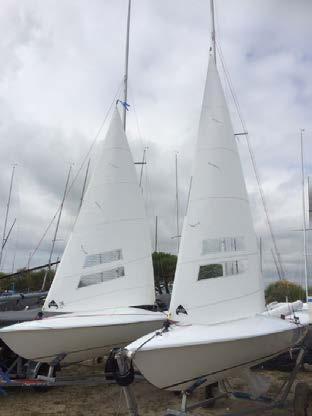

Some chute boats have experienced spinnaker halyard fouling when the jib is being furled. This occurs because the jib head is closer to mast and more likely to catch on the spinnaker halyard. Murphy’s Law states this is most likely when the jib is being unfurled in the prestart with 15 seconds to the gun. Some boats have added a CD sized disc at the head of the jib to prevent fouling, but another top tip is for the crew to reach out onto foredeck during the prestart and pull the spinnaker halyard down an extra couple of feet in the prestart. A slack spinnaker halyard substantially lessens the risk of fouling.
The shorter foot and longer leech means that the clew that sits forward and lower compared to the old genoa. This means the jib fairlead will need to be adjusted forward. As a starting point, Ian Pinnell (P&B) suggests a fairlead position 3150mm from the transom. This is also 350mm forward of the P&B recommended genoa position.
This measurement depends on the forestay position, but is a good guide to the maximum forward position of the jib fairlead. In many cases, this can be managed on the existing jib track, but in some cases the track will need to be either extended forward or moved.
Jib Clew
FLYING FIFTEEN WORLD — FEBRUARY 2022 16
The Genoa and the Jib Side-by-Side
The shorter foot also means that that the jib should be trimmed closer to the centre to maintain the same sheeting angle as the genoa. The simplest way to think of this is to draw a line from the tack back to the genoa car. The new jib car position will be on this line – forward of the genoa car and slightly inboard as well.
At the pointy end of the fleet there has been a lot of experimentation with the clew position – not only moving the fairlead forward, but also experimenting with even tighter sheeting angles. Some top sailors have discovered that in the right conditions the boat can be sailed on even tighter sheeting angles – pointing higher, though not necessarily faster.
The advantages of pointing higher and slower are mostly at the start when holding a lane is crucial, but there are other occasions when it can be useful. However, Steve Goacher (Goacher Sails) cautions that sailing in high mode is like “sailing on the edge of a knife as you run a high risk of closing the jib/main slot. Any sudden drop in wind pressure could bring the jib inward and, in a gust, easing the main to manage a gust also risks closing a narrow slot. It’s fast, but unforgiving.”
Richard Lovering (Hyde Sails) agrees, noting that it only really works “in a narrow wind range when the boat is full powered. In lighter and heavier winds having a wider slot is more and tight sheeting angles won’t work. We use the same sheeting angle on the new jib as we had on the genoa, but to achieve this we moved the tracks forward and inboard.”
Although many of the top boats follow Richard’s example, relocating the tracks as close to the vertical section of the side tank as possible, it is interesting to look at the other systems being tried and tested. I’ve tried summarising four options below:
Cost
Putting it all together, most sailmakers sell the new jib for either
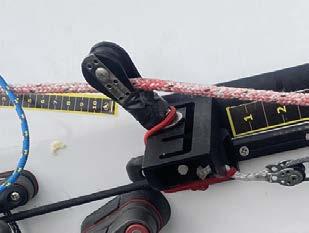
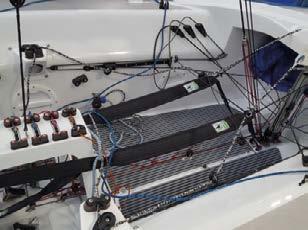
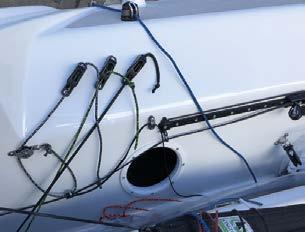
Boat Description
4071
“470 Gearbox”
4078
“470 Goachauler”
side £450 depending on whether they are running a sale. The shorter halyard will set you back a further £40, and a further £15 for the halyard lengthening strop if you wish to cruise with your genoas from time to time. Some crews have added a disc to the halyard, adding a further £5.
So, the minimum spend is about £500. You can add £100-200 if you need to lengthen or move the tracks, or add a system to manage the clew position – and a bit more if that work is undertaken professionally. All-in-all, about £500-700 – or £50-£250 above the end-of-life sail replacement cost.
Conclusions
Interestingly, in collating this article, the feedback and experiences on the new jib were universally positive across the board. For some, planning clew systems and testing how they perform on the water has improved their enjoyment of the class.
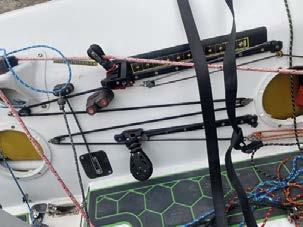
The old style genoa is still commonly used in club racing fleets, but as these sails age many classic Flying Fifteens are looking at the new jib and what it means for their boats. There has been some reluctance, with stories of snapped halyards, moving jib tracks and spinnaker halyard fouling making the rounds. However, with four years of fleet-wide experience, these problems have been solved.
In short, the new jib has been a welcome addition to the class and a worthwhile investment.
Acknowledgement
UK FFA wishes to thank Steve Goacher, Ian Pinnell, Richard Lovering, Richard Whitworth, Charles Apthorp, Nathan Batchelor, Jeremy Davy, John Hanson, Alastair Stevenson and Mervyn Wright for their insights. Picture credits to Nathan Batchelor, Richard Jones, Jeremy Davy and UK FFA.
The International 470 approach uses a ‘gearbox’ to adjust the jib block inboard, while the jib car fore/aft position is adjusted while hiking. The jib track has been moved forward as close the vertical section of the side deck as possible. This system was used by Graham Vials and Charles Apthorp at the 2019 Worlds, but requires the jib track to be moved onto the vertical side tanks of the OviX. The Gearbox is available from Mackay Boats in New Zealand, although Allen Brothers produce a similar version in the U.K.
First used by Steve Goacher at the 2019 Worlds in Ireland, the inboard puller pulls a floating block in front of the jib fairlead. The puller runs to the windward side of the boat to a fairlead just in front of the jib track and then, via a 2:1 purchase, to a side cleat. This enables the sheeting angle to be adjusted on the windward side of the boat while hiking.
The system is cheap, simple, and doesn’t require the tracks to the moved inboard. While it does mean more string crossing the boat, it should (in theory) be out of the way of the crew.
FLYING FIFTEEN WORLD — FEBRUARY 2022 17
4073
“Twin Tracks”
Chris Ducker’s new boat uses custom ‘pods’ added to the side wall to run the main jib track, setting a maximum inboard position. The jib sheet then runs through an out-hauling block which is adjusted on the secondary track. The jib cars on both tracks are linked. This system was put together by Phil Evans (Phil Evans Sailing Services) and a video of the system can be found on YouTube.
3760
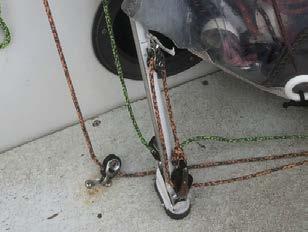
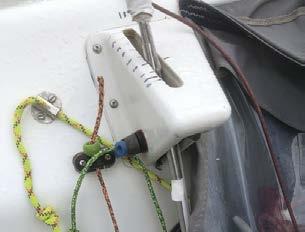

“The Postitionator”
Jeremy Davy’s “Positionator” takes inspiration from the Fireballs and moves away from jib cars to a system that adjust the jib block up and down, and inboard and out. This can be adjusted by the crew while hiking. MkV is pictured, MkVI has now been fitted!
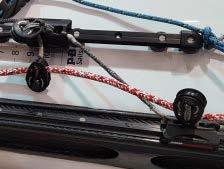
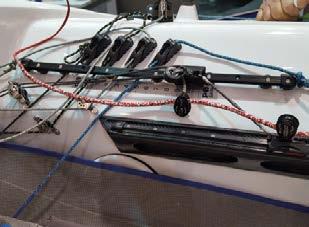
Jack was many things to many people and indeed he wore many hats but to the Irish Flying Fifteen Class he was a huge influence both during his sailing days and long after during his race officiating where he was always keen to do Fifteen events and keep in touch with current people and developments both in Ireland and abroad.
Jack sailed with Mal Nolan from 1981 to 1993 when he sold his last Fifteen. He performed in several World Championships including Kinsale (1984) and Dublin (1992) before progressing to PRO for the World Championships in Dublin in 2003 and more recently in 2019 as well as assisting in New Zealand in 2005.
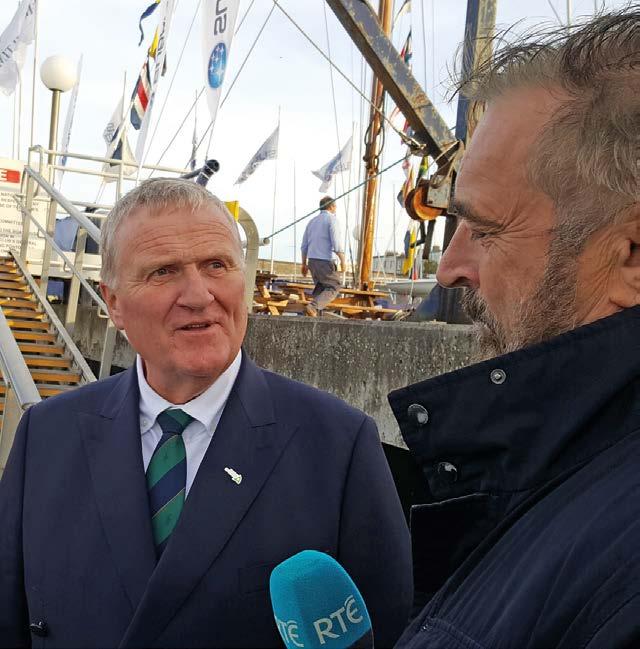
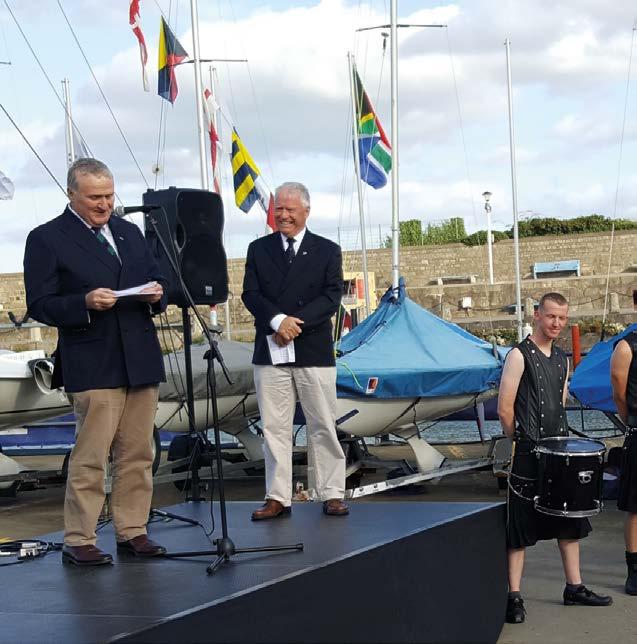
His firmness and kindness made a good blend and competitors always felt comfortable in his presence.
Jack was instrumental in forming the Flying Fifteen Association of Ireland where he was able to do what it took to combine both the southern and northern fleets who up to that point sailed under BIFFA.
Jacks untimely death follows very soon after another of our stalwarts Gerry Donleavy who died in October. Both were members of the National Yacht Club, and the club, the class and the sailing community will miss them both. Sail on Jack and Gerry!
FLYING FIFTEEN WORLD — FEBRUARY 2022 18
Jack Roy (1958-2021) RIP.
Part One – An overview of the measurement process Boat measurement is one of those things that we all think we understand but few of us have actually been through. Although nothing about the process is particularly difficult there is nonetheless a learning curve to climb when first taking a boat through measurement and this article may help make that climb a little less steep.
First, to state the obvious: - the Flying Fifteen is a one-design class with no limitations on who can build hulls or supply equipment. Thus, a Flying Fifteen doesn’t become a Flying Fifteen until it’s been through a comprehensive measurement process to ensure that it complies with the class rules; it’s worth emphasizing that it’s the issuing of the measurement certificate, not the issuing of the sail number, which is the critical point here – in fact the boat must have already been issued with a sail number before measurement can take place.
Who does what?
As an International class the Flying Fifteen class rules are administered by its international class association (FFI – Flying Fifteen International), with FFI’s Chief Measurer being Graeme Robinson of New Zealand. FFI oversees the various National associations (UKFFA in the UK), and each of these also has its own Chief Measurer (Simon Patterson in the UK) plus a team of Official Class Measurers and Maintenance Measurers.
Getting the Measure of things
Maintenance Measurers, and sails can also be measured by In-House measurers appointed by World Sailing or a National governing body.
Pre-championship check-measurement, incidentally, can be carried-out by any person acting under the supervision of a class measurer.
Reasons for Measurement
The primary point at which measurement takes place is of course when a boat is newly built, but the class rules also require full measurement when ‘substantial alterations to the hull’ have been carried-out to an existing boat, or indeed if a hull has been entirely replaced. Owners of Classics & Silvers should note that such hull alterations may also result in their boat being reclassified into a different fleet.
Partial re-measurement of existing boats may be required on the instructions of World Sailing or their affiliates (i.e., the RYA etc) or by FFI or its affiliates (i.e., UKFFA etc), or by an event Race Committee.


Partial re-measurement of an existing boat in the form of re-weighing might also be instigated by the boat owner themselves once 12 months have elapsed since first measurement. Note that the re-weighing still requires the keel, buoyancy, cordage and other equipment to be removed from the hull and that any corrector weight changes must be officially recorded and a new measurement certificate applied-for.
As already mentioned, new sails are now often supplied pre-measured, but if not, the boat owner will need to arrange for this to be done - and note also that the details of any new sails must be recorded on the boat’s measurement certificate by a class measurer (that is not just added by the owner) in order to ensure compliance with class sail limitation rules.
Sailing as a sport is governed internationally World Sailing and their role includes the governing the Flying Fifteen class rules along with those of all other class associations. Operating beneath World Sailing are various National sailing authorities, with the UK’s being the Royal Yachting Association, and thus it is the RYA that is the certification authority for the Flying Fifteen class.

Full measurement of new boats – and the re-measurement / re-weighing of existing boats - can only be carried-out by Official Class Measurers ratified by FFI. Other tasks – essentially those from Rule B9 onwards in the class rules – can also be carried-out
Lastly, except for pre-measured sails, owners should be aware of rule A8 if they intend to replace any of the measured components on an existing boat - it being their responsibility to first arrange for the legality of the replacement component to be checked by an appropriate measurer. In other words – if a replacement mast is required the owner should first arrange for it to be inspected by a Maintenance Measurer, and if a new rudder is to be fitted then the services of an Official Measurer will be required.
Part Two - A practical guide to the measurement of new boats

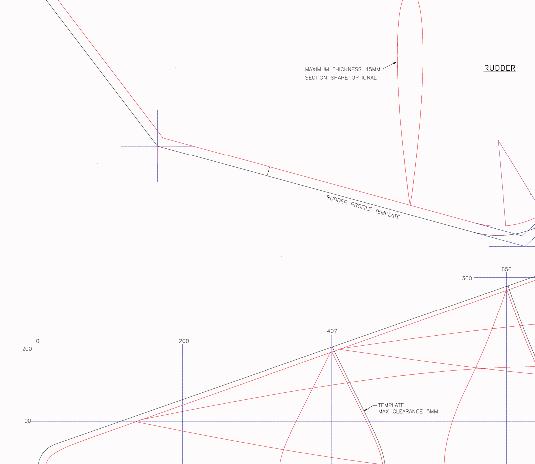

The information below is intended primarily for those owners who are either building a new Flying Fifteen from scratch or (much more likely) fitting-out and completing a bare GRP hull.
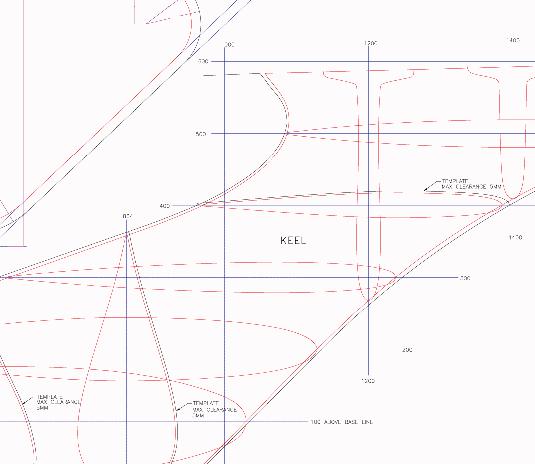
FLYING FIFTEEN WORLD — FEBRUARY 2022 19
Explaining the Flying Fifteen measurement process from the boat owner’s point-of-view
Firstly a quick word about Measurer philosophy. Everything you’ve read in this article so far may have given you the impression that the measurement process is strict and highly regulated, and while that’s technically true it doesn’t mean that Measurers are in any way ruthless or unsympathetic. In fact quite the opposite is true and all our class Measurers are great Flying Fifteen enthusiasts who will bend over backwards to help owners and builders, and who will do their very best to help you get your boat through measurement - so don’t be afraid to ask if you need help or advice at any stage of the build process.
There now follows an uncomprehensive and non-official stepby-step guide getting your new boat measured and registered:
1. During the building stage
The Flying Fifteen class rules are available to download from the FFI (not UKFFA) website, and builders should obviously make themselves familiar with the relevant rules before tacking each aspect of their build.
In terms of fi t-out you will fi nd our class rules generally much less restrictive than those of many other classes, but be aware that in some cases several rules interact with each other and must considered together before you start drilling holes; a prime example of this being the relative positions of the chainplates, mast gate and furler mounting points. Don’t do as I did and start by copying the chainplate positions from another boat on the assumption that “they must be right”, only to then have to move them further back after realizing that I’d unnecessarily restricted where the mast could sit within the gate.
Note that if your build includes constructing a rudder or finishing a keel it will be essential to have a copy of the keel & rudder templates (Plan 97/2) in addition to the rules themselves. The class Secretary will send you these as an email attachment upon request, with the attachment taking the form of a PDF file containing a technical drawing showing keel & rudder in profile and section – with the horizonal and vertical sectional views provided matching those of the offi cial measurement templates. So, by getting the PDF file printed-out at exact full size by a plan printing bureau you can then create your own temporary set of measurement templates and thus be certain that your keel and rudder will measure correctly.


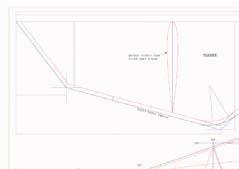
2. Preparing the boat for measurement
It’s natural to regard measurement as an irksome hurdle to negotiated during the build process, and you may be tempted to get the boat over that hurdle as early as possible on the basis that the keel and various other items cannot be fitted until it’s been completed.

This isn’t good practice though since a major element in measurement is the official weighing of the boat, and to be sure that you’ve maximized the recorded weight (and thus minimized the required correctors) it’s far better to get the boat as fully finished and ready to sail as possible, then go back and remove the minimum number of non-permitted items required for weighing to take place. As part of this incidentally it’s perfectly acceptable to ‘sew-in’ certain ropes to render them ‘fixed equipment’ rather than removable rigging, and it’s sometimes also possible to ‘hold-up’ loose cordage during weighing to prevent its weight registering on the scales.
It should be noted incidentally that the class rules do not permit weight to be added to the hull which is neither necessary for the boat’s construction or fit-out – specifically you cannot add your own ‘unofficial’ weight to the hull before it is measured and before the official corrector weights are fitted.
Items which may not be fitted to the hull during weighing are listed below, but bear in mind that many of these items must still be presented for inspection as they are subject to their own measurement:
• Keel
• Keel bolts (see note below)
• Rudder, tiller & tiller extension
• Spars, inc. spinnaker pole(s)
• Sails
• Removable cordage & rigging
• Removable buoyancy
• Equipment such as paddles, hand bailers, compasses, pumps etc
The rules specify that “keel bolts or studs” are weighed with the keel; no mention is made of nuts, but Measurers take these to also be included since a stud with a nut is the equivalent of a bolt. What aren’t include in the keel weight though are keel bolt washers or backing plates, but fortunately a little glue or double-sided tape will render these a permanent fitting for hull-weighing purposes.
Finally, it’s worth mentioning that some items – hand bailers, a paddle, an anchor and so on – are required by the class rules when racing but are not part of the measurement process. But these items – plus other equipment such as towing lines – WILL be inspected on other occasions, such as during event scrutineering.
Arranging Measurement
Also, essential if fi nishing your own keel – and useful if just fitting-out a hull – will be your own set of scales. I remember years ago hiring a 500kg digital loadcell at some expense to weigh a Flying Fifteen, but nowadays you can buy the same thing outright for less than £50. Whilst my boat was being measured earlier this year, I very cheekily did a side-by-side comparison test of my scales against UKFFA’s official set and found the readings to be all-but identical.
Although you can register your new boat at any point this is again something you ideally want to leave until the last moment to be sure of receiving the latest possible sail number - which you’ll then proceed to carve into the hog of your hull using a Dremel or similar (Editor’s Note: it is being considered making the Sail number allocation at the time the hull is actually built, with the hull supplied with the number already carved so this may be irrelevant in future)
Sail numbers are issued by the Secretaries of each National association on behalf of FFI upon payment of the Registration Fee, part of which is passed on your behalf to World Sailing and in return for which you will later receive a World Sailing plaque (i.e., the familiar blue sticker) for attachment to your boat.
FLYING FIFTEEN WORLD — FEBRUARY 2022 20
At the same time as paying the Registration Fee you’ll probably also be paying the Measurement Fee which pays the expenses of the individual Measurer who’ll be coming out to inspect your boat. By this point you may have already contacted your nearest Measurer (see FFI website for a list of names), but if not, the class Secretary will put you in touch with the right person. Then it’s just a question of arranging a time and place with them, the only requirement for the latter being the availability of a chain hoist, or similar, to lift the hull and keel for weighing.
As the boat owner / builder you’ll be expected to be present whilst measurement takes place and will no-doubt find yourself holding the end of tape measures at times and assisting generally. And of course, you’ll need to have already worked out the logistics of moving the separated keel and hull around so that the Measurer can weigh them.
Correctors are usually made from lead sheet cut to whatever length your scales tell you is required, then folded into a block and securely bolted (“through-fastened”) into the boat. Each corrector must have its weight marked on it and be mounted such that it is “clearly visible in the cockpit area” - which can include bolting it to the hog beneath the removable floorboard

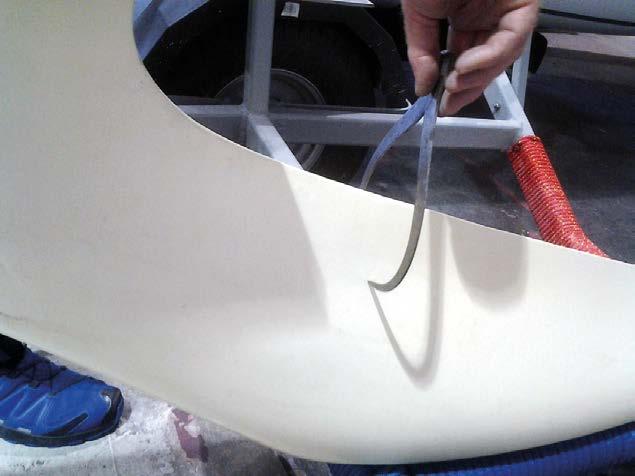
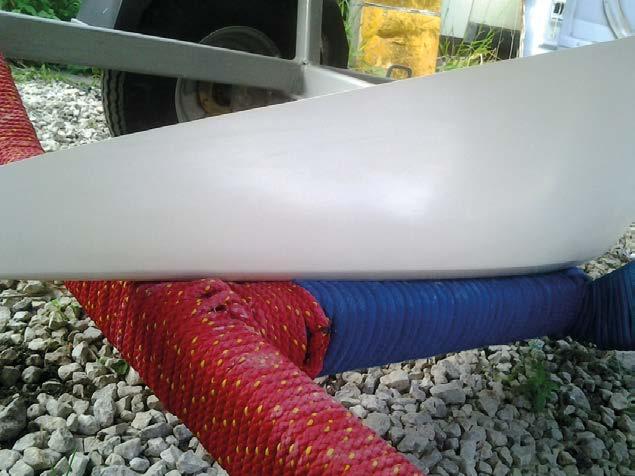
Once the correctors are in in place the measurer will wish to arrange some form of inspection to ensure they are fitted to the specification required in the class rules, and of course your boat will also very likely be weighed and the correctors checked on future occasions during pre-event scrutineering.
Once your Measurer is satisfied that everything is in order he will complete and sign your boat’s measurement form and send it to you by post (and buy him a beer next time you see him!), whilst the class Secretary will issue you with the previously mentioned World Sailing plaque.
The final step in the measurement process is to apply for your measurement certificate, which the RYA will issue to you upon receipt of your signed measurement form (which they will return to you) and payment to them of the required fee. Once you’ve received your measurement form remember to record onto it the details of any sails you will be using on the boat.
Oh, and at this point you can bolt your keel on and go sailing!
About the Measurement process itself: -
All new Flying Fifteen hulls and foils are subject to full measurement, although owners with moulded GRP hulls or rudders should have no concerns. Keel can be a different story though since every keel is a one-off both in the way it is cast and the way it is hand-finished. Keel measurement tolerances are quite tight too, and this is exacerbated further by the current trend towards ‘keel chines’ – in other words finishing the bottom edges of the keel with a corner rather than being fully rounded as shown on the keel plans.
After the big day
During the measurement process itself the Measurer will have recorded the details of your boat into an 11-page class measurement form and will have course have discussed with you any issues that may have arisen.
If there were any failure points it’s now your job to carry-out any rectification work required and submit those items for re-inspection – which in a worst-case-scenario, for instance hull shape discrepancies or an under-weight keel, might mean arranging a whole new measurement appointment.
The other thing that the Measurer will have told you is the total corrector weight required by your boat, and you now need to create and fit one or more correctors to make up this total.
Jeremy Arnold
Note that the keelbolts are included when weighing the keel
FLYING FIFTEEN WORLD — FEBRUARY 2022 21
Don’t overdo those keel chines!
GBR4091 Photo GalleRy
A home-finished Ovington 10 with some custom touches. Words and photos by Jeremy Arnold.
5. A double-acting mast ram mounted under the foredeck pushes & pulls the mast at a point several inches above that of a conventional lever. The three plain-bearing blocks on the side of the mast ram guide the spinnaker pole downhauls and the (yellow) jib furling line .
6. The spinnaker pole lazy guys travel through tank tubes down to the cockpit floor.
7. The calibration gauge on the left side shows the (magnified) position of the mast in the gate. The cleat for the spinnaker chute cover is mounted behind the blue slot on the right side.

8. The black mainsheet bridle lines exit the rear of the console, run along the floor as shown here, then lead through tank tubes up to the mainsheet attachment points on the rear deck.
9. The outhaul & cunningham cleats mentioned earlier can be seen here, complete with their ‘tripping levers’ (the stainless-steel arms coming out sideways). Note that the cleats themselves are quite cheap items – Harken cleats holding the ropes too well and being very difficult to trip!
1. Probably the most significant feature of 4091 is its custom centre console which has almost every control led to it but which is also narrower than a standard Ovington item to give a bit more cockpit space. As well as all the stuff on the outside of the console its interior is also pretty busy as it contains three carbon fibre ‘winch drums’ – a central large one which powers the kicking strap (thus eliminating the usual kicker cascade purchase), plus two smaller ones which provide the purchase for each of the lazy guys for the twin spinnaker poles.
Also visible in this photo are the custom jib cleat platforms which also incorporate the spinnaker sheet turning blocks and cleats, the spinnaker sheet tank tubes having been extended to this point.
Also note the lack of visible rope and shock cord attached to the jib car itself, this all being instead led below the floor – I will freely admit though that my obsession with making things as neat as possible went a bit overboard here.
2. The labels are all self-explanatory here I think, and notice that although the outhaul & cunningham lines are led to the console they are not cleated there – instead their remotely-tripped cleats are mounted down by the mast step, with the loose tails being pulled back through the console and under the floor by shock cord.
Also, notice the all-important banana & Mars Bar stowage facility!
3. A close-up of one of the jib / spinnaker sheet platforms which also incorporate a hidden third cleat for the (vertical black) line which controls the jib car on the opposite deck. Working out the correct geometry for these platforms took ages!
4. Home-made ‘E gate’ device for athwartship positioning of the jib block.
The high-load (all metal) block beneath the cleats is for the kicking strap – the kicker leading directly from the boom, around this block, and then back to the winch drum inside the centre console.
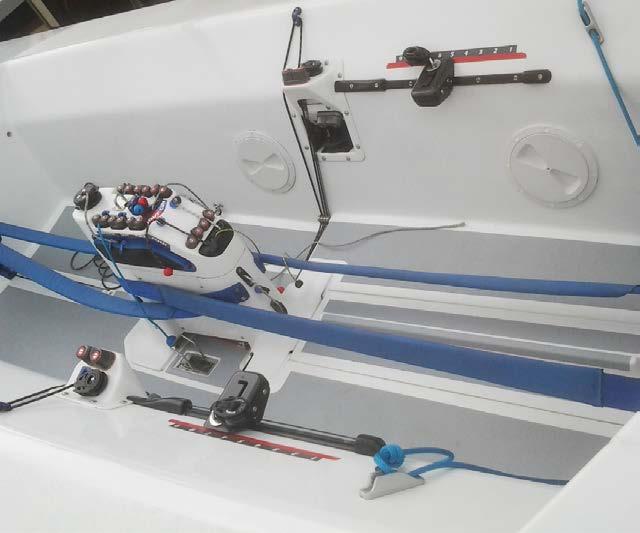
The carbon tubes running down either side of the tunnel house a two-speed purchase system for each of the spinnaker guys. Most of the spinnaker guy purchase comes from their winch drums in the console, but there is also an additional 2:1 purchase inside these tubes which only operates for the last third or so of the guy’s travel, when the loads on it are at their highest – ie. when you’re sailing on a reach with the spinnaker pole forward against the forestay.
10. The enclosed console sides meant special arrangements were required for the corrector weights to be visible!
Also shown in this shot is the custom moulding made to cover the mainsheet bridle lines as they run along the centreline of the floor. Without this I’d undoubtedly have found a way to trip over them during some critical manoeuvre.
Finally, notice the neatly recessed self-bailers!
2.
FLYING FIFTEEN WORLD — FEBRUARY 2022 22
1.
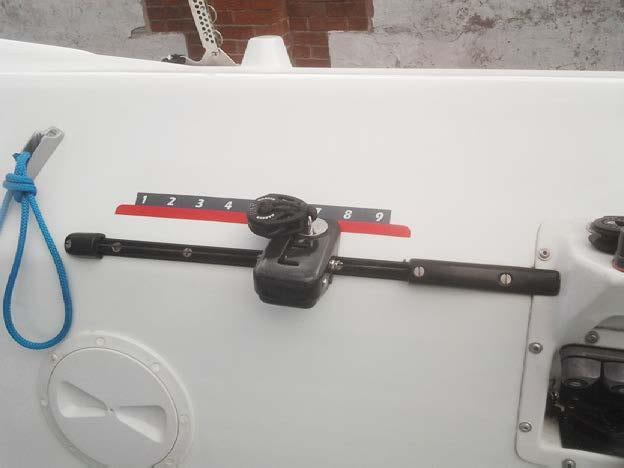
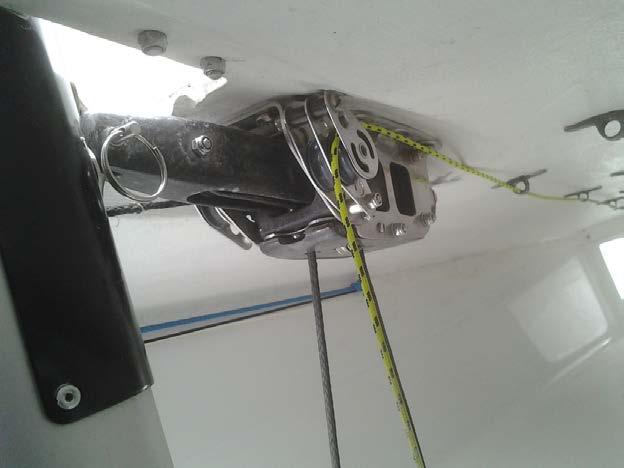
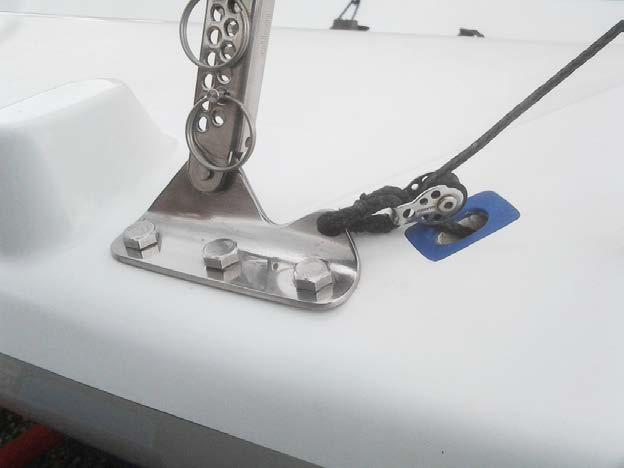
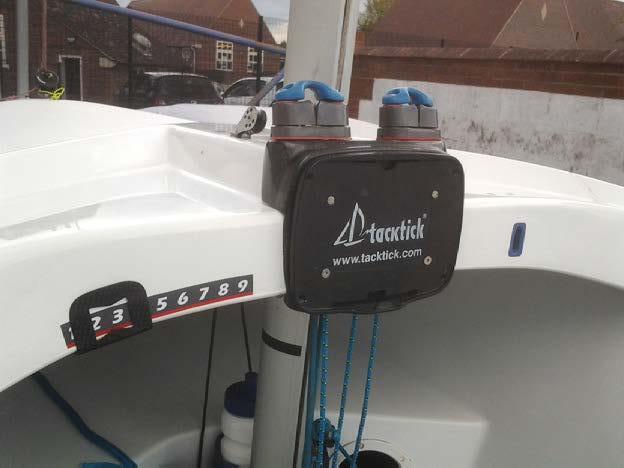
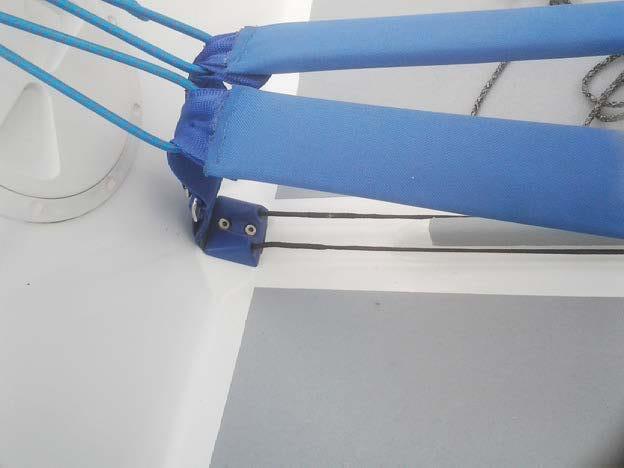
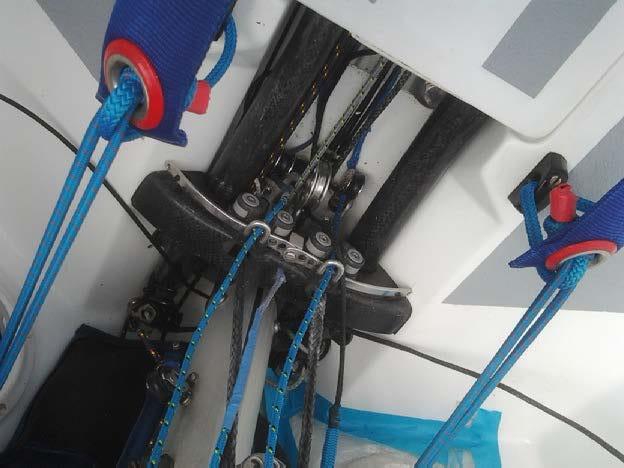
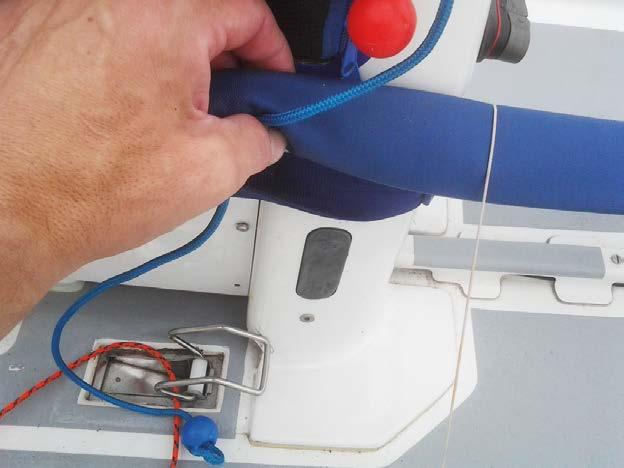
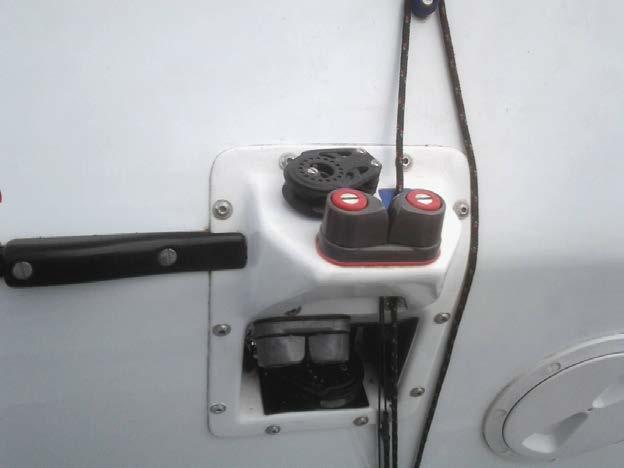 3.
4.
5.
7.
9.
6.
8.
3.
4.
5.
7.
9.
6.
8.
FLYING FIFTEEN WORLD — FEBRUARY 2022 23
10.
Finishing a Keel at Home
The option of buying a bare Flying 15 hull and fitting it out yourself continues to be a popular route into a new boat, but very few home-builders seem willing to go the extra step of also finishing and fitting the keel themselves. Having recently undertaken this task myself I can report that the job is probably more straight-forward than it seems, although as this article explains there are definitely one or two things to know beforehand
I should mention, incidentally, that before taking the plunge myself I was fortunate to be able to get lots of good advice( that is, nag repeatedly) from fellow Notts County SC member Andy Farmer, and also from Steve Graham – both Andy & Steve are ex-P&B and I’m grateful to both of them for giving me the confidence to take the job on myself and reject the easy option of just paying someone else to do it.
Equipment & Tools
The cost difference between a bare casting and a finished & fitted keel is in the region of £1,500 which I think is a fair representation of the labour involved at professional rates - there being little actual expenditure required beyond the paint and the keel bolts. What IS required though is the necessary equipment to lift the keel and the hull (separately and together), plus some scales with which to weigh the keel.
Another item of equipment you’ll need is some sort of stand to hold the keel upside-down whilst you work on it; you’ll undoubtedly have to fabricate this yourself and it demands a bit of thought as the shape of the Flying 15 keel makes it a very unbalanced weight when upside down, and you definitely don’t want it falling on you. I believe P&B and Ovington have purpose-made trolleys on which an inverted keel can be mounted and maneuvered, and I crafted a similar arrangement by lashing some long planks of wood to the legs of the engine crane I was already using to move the keel about.
The final thing you’ll need is your own set of keel measurement templates, and again you’ll need to make these yourself.
The Flying 15 keel and rudder lines plan – ‘Plan 97/2’ – is referenced in the class rules but is a separate document which, upon application to the Class Secretary, will be sent to you in the form of a PDF file attached to an email. The lines plan could be used to build a keel (and rudder) from scratch if required, but of course we just need a set of templates to check the shape of an existing one - and these are easily produced since the plan shows the sectional shape of the keel at each of the vertical and horizontal measurement stations specified in the rules, plus of course the overall profile shape of the entire keel.
Creating your own measurement templates is therefore just a matter of getting the PDF file printed onto paper, spray-mounting that paper onto the sheet material of your choice, then carefully cutting your templates out. Note that to get a full set of templates you’ll actually need three copies of the paper plan because some of the templates are shown overlapping.
For accuracy you really want your templates to be cut from something both thin and stiff – something like aluminum or acrylic (Perspex) sheet would be ideal, but thin plywood fitted

with a reinforcing framework can be made to work if you’re cheap (guess what I used!). It’s the large profile template – the one that fits around the entire keel perimeter – that’s going to give you problems if it’s able to flex and change shape.
Learning Curves
There are two companies casting Flying Fifteen keels and I chose Iron Brothers in Cornwall, with the casting subsequently arriving at my house strapped down to a pallet and finished with a modern epoxy version of red oxide. I was pleasantly surprised by the surface finish of the casting, and indeed turning it into a finished keel required much less ‘bodywork’ than I’d been expecting.
Another surprise was that the keel mounting holes had threads tapped in them which, even two years later, I still haven’t decided is a good thing or not - a tapped hole makes installation of the keel much easier (especially when working single-handed), but at the expense of requiring perfect alignment of the keel bolt holes in the hull.
Keel as delivered, shown here sitting on a home-built wooden stand on a set of 300kg postage scales (which I subsequently stopped using as I found they gave inconsistent readings)
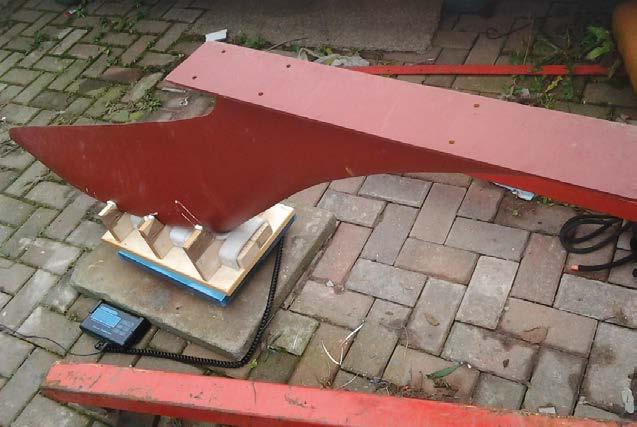
Having received the casting the first job was to weigh it, and it was here that I learned probably my biggest lesson of the whole project. The class rules specify a maximum and minimum weight for the keel, and quite reasonably Iron Brothers - whose main job is producing keels for production yachts - had supplied a casting within these two limits. But as racers we of course want a keel that’s exactly on the minimum weight, which means starting with a casting that’s below the minimum.
I subsequently learned that the professionals (ie. P&B and Phil Evans etc) request the foundry to produce their castings with an extra-deep ‘box’ in order to reduce their weight slightly – the box being the void in the bottom of the keel casting which the class rules permit for weight-adjustment purposes. Since my casting had a standard-sized box and was already over the minimum weight I had no choice but to spend a great deal of time drilling and grinding material out of the bottom of the box myself – part of my driveway now being permanently rust-coloured from the copious quantities of iron filings produced.
FLYING FIFTEEN WORLD — FEBRUARY 2022 24
Horror Stories
More than one person had scared me with tales of freshly made keel castings twisting or distorting slightly as they cool, and although I don’t really know how real such horror stories are I was determined to check mine. The problem though is that there is no easy way to check that something is ‘straight’ overall when it’s every surface is curved; what I did therefore was to lay the keel on a piece of tarpaulin which was then turned into a water pool with some house bricks and a hosepipe – and was relieved to be able to get the water level perfectly aligned with the keel centreline at all points.
The only place where material was removed from the keel to improve its shape was the top half of the leading edge, which was thicker and blunter than I was happy with. Lots more work and iron filings to stain the drive! Then it really was time for paint, this being the usual high-build primer and (brutally tough) Durepox topcoat.
Fitting the keel
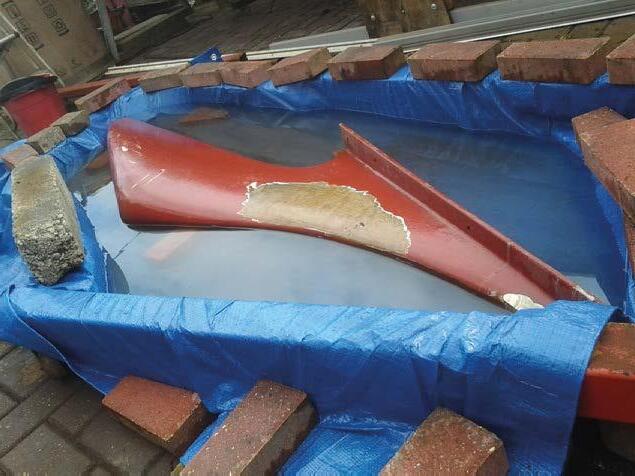
From the outset this was the part of the project which had scared me the most, not just because the keel alignment itself is critical but because the keel bolt holes must be drilled at precisely the right angle through the hull - and those holes are much deeper than you might imagine. Again there are precious-few straight edges anywhere that can be used to align things, plus the fact that that the Ovington inner hull moulding is a long way from being symmetrical.
There is really no advice to give here other than to first get the hull perfectly level and then find as many different ways as possible to measure and check everything that you can possibly think of. I also made a drilling jig to ensure that the holes themselves were spaced and angled correctly.
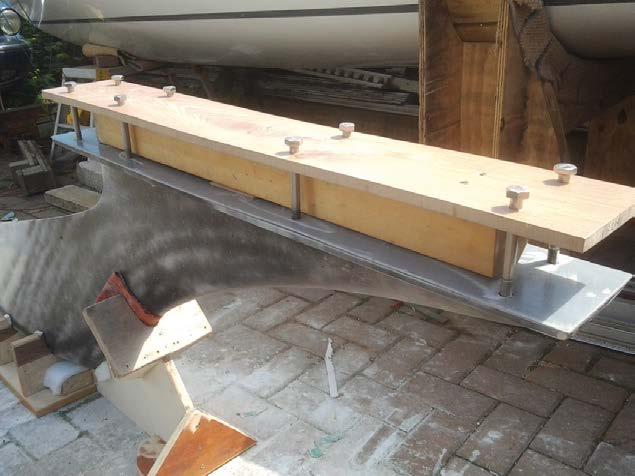
We now have a keel that is known to be straight and, after a lot of work, slightly below weight. The templates also showed it’s measured shape to be fine everywhere except being slightly short of material at both its extremities, which is something I’d been told to expect and is probably due to shrinkage during cooling or some such. The actual fairness and surface finish of the casting is very good indeed and once a bit of bodywork was done to those shrunken extremities it’d be possible to proceed directly to painting. But should we try to do more?
I suspect most keel shape theories have no value beyond being a topic for bar-room discussions, and in any case it’s worth remembering that the keel is a big dumb lump of cast iron and not something that you can easily change the shape of anyway. So, we can forget trying to do anything clever with the shape, but there has got to be value in ‘blueprinting’ it (that is. ensuring it is perfectly symmetrical), and the basic optimization stuff - maximizing length, depth & lateral area – is all easy to do since those jobs will all involve adding material rather than taking it away.
One obvious place to start is the aft end of the keel, which Uffa designed with a broad, rounded tip but which on many Flying 15s is tapered-down to quite a sharp and narrow point – and indeed this becomes almost the default shape unless you make a point of adding extra material to the casting.

Since I wanted a maximum-length keel with a maximum-area tip I welded extra steel to its aft end and also (in order to maximize the keel depth) welded a steel plate right over the top of the ‘box’ (after filling it obviously) rather than just leaving it flush with the bottom of the keel. Then the whole of the keel bottom was faired and shaped with micro balloons, with a lot of attention paid to its symmetry .
The GRP hull incorporates a substantial chunk of timber in the hog and the keelboats obviously pass through this. For sealing purposes it’s normal practice to drill the bolt holes substantially oversize, fill them with epoxy, then drill the final holes through that epoxy. I achieved the same effect by bonding lengths of carbon tube into each of my (less oversize) holes, with the keel bolts being a perfect fit inside the tubes.
And that’s about it; Once the finished keel had been measured and weighed it was final-fitted to the hull with a gasket cut from neoprene sheet, the keel bolt holes filled and the flange joint tidied-up. Job done. And to answer a question I’ve been asked several times – Yes, I will happily do it again on the next boat.
Jeremy Arnold
Happy confirmation of a non-twisted keel
FLYING FIFTEEN WORLD — FEBRUARY 2022 25
A drilling jig was made on the keel itself, then transferred to the hull
Flying Fifteens at Cowes 2022
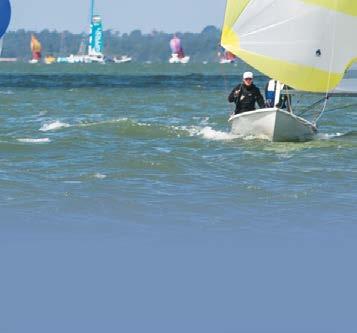
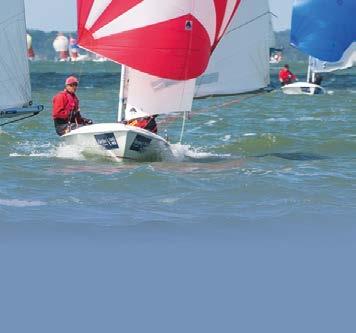
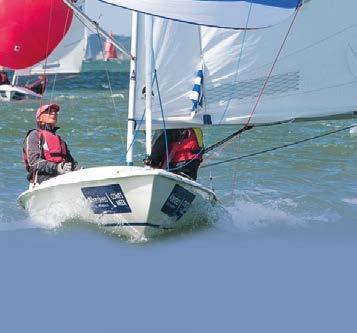
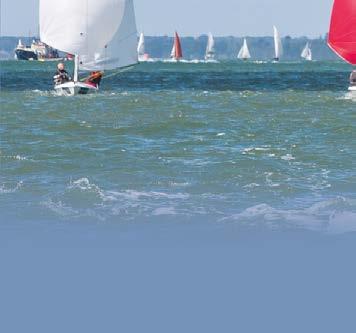
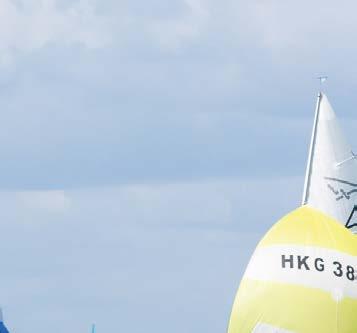
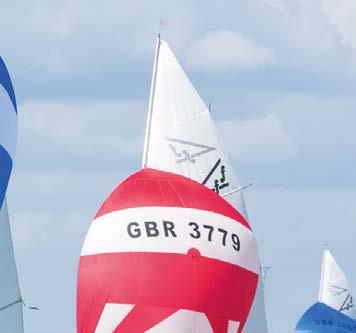
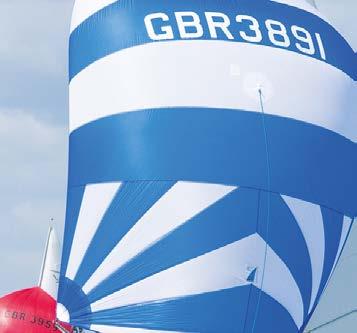



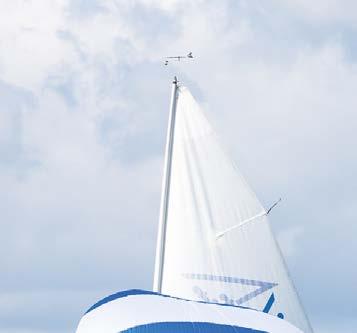

Cowes can probably be regarded as the spiritual home of the Flying Fifteen as it was the home of designer Uffa Fox where, at the request of the chairman of the RYA Dinghy Committee, he first drew up his vision in 1947 for a lively planing boat for more mature dinghy sailors unable to sit out! The class has moved on a long way since the boats Uffa built in those early years.
Cowes has been the venue for anniversary regattas since 1997 when the class held a two-week jamboree which included the World Championship. In total 184 Fifteens visited Cowes over that fortnight. Since then, the Diamond Jubilee Regatta was held in 2007 and Southern Area Championships were held in 2012 and 2017 to mark 65 and 70 years respectively.
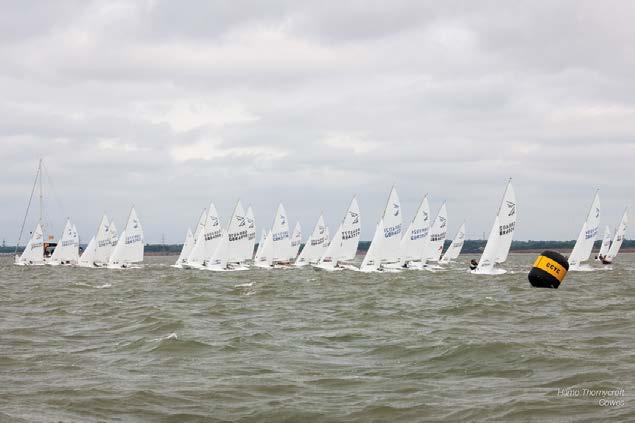
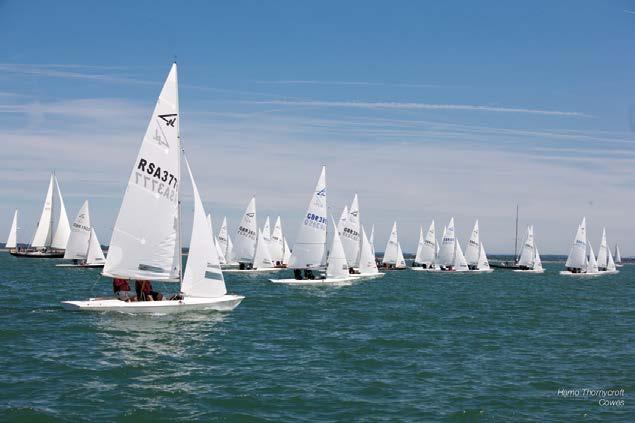
Therefore, it seems appropriate to come to Cowes again in 2022 to mark 75 years with a regatta to include the European Championship to be run by the Cowes Corinthian Yacht Club (CCYC). By late December it is looking very encouraging with over 80 expressions of interest since the regatta website www.ff75. org opened. The format of the regatta will be to launch the boats that trail to Cowes on the afternoon of Saturday 20th August. This will be followed by 5 days of racing starting on Sunday including
a special one-off race from the Royal Yacht Squadron (RYS) line to mark the anniversary. The boats will be recovered on Friday. Socially the regatta will open with a drinks reception at the RYS Pavilion and Lawn on Sunday and then on Tuesday we have been invited to the boathouse and quay of the Commodore’s House, Uffa’s last residence, for an evening reception. Further socials will be laid on by the host club and for those not familiar with Cowes there are numerous bars and restaurants in the half mile long High Street.
2022 will also see a separate regatta open to all Uffa designed boats immediately before FF75 to commemorate 50 years since Uffa Fox passed away; this might be of interest to Flying Fifteen sailors as well. Details can be found on the website www.uff afox2022.org. Two days of racing will be run by the Royal London Yacht Club (RLYC) on 19/20th August. Th e local Classic Boat Museum will be heavily involved in the event and it has many examples of Uffa’s boats on display as well as much archive material. There are also moves afoot to try to get Coweslip back to Cowes for the August regattas. The two clubs will work together to facilitate anyone wishing to take part in both regattas.
FLYING FIFTEEN WORLD — FEBRUARY 2022 26
Photos by Hamo Thornycroft
If anyone would like to get experience of racing Fifteens in the Solent prior to these two regattas, Cowes runs two open regattas during the season that welcome the class. Cowes Week will start on Saturday 30th July, see www.cowesweek.co.uk/. The format is one race per day for seven days. The races are typically 2-3 hours long, racing around the cans. It can be a test of endurance if you join in with the busy social programme available. In 2021 Cowes Week had the largest fleet of Fifteens for at least 10 years which included former world champions Rupert Mander and Charles Apthorp.
Cowes Classics Week is open to Fifteens of all ages (the design date determines eligibility) and will run from Monday 27th June for five days with two races per day. The races are largely windward-leeward and trapezoid courses, or sometimes an around the cans race to get back to Cowes. Details will be available here www.cowesclassicsweek.org. Cowes Classics Week enjoys a full social programme, although not as hectic as Cowes Week, and includes tea and cake after racing every day at RLYC.
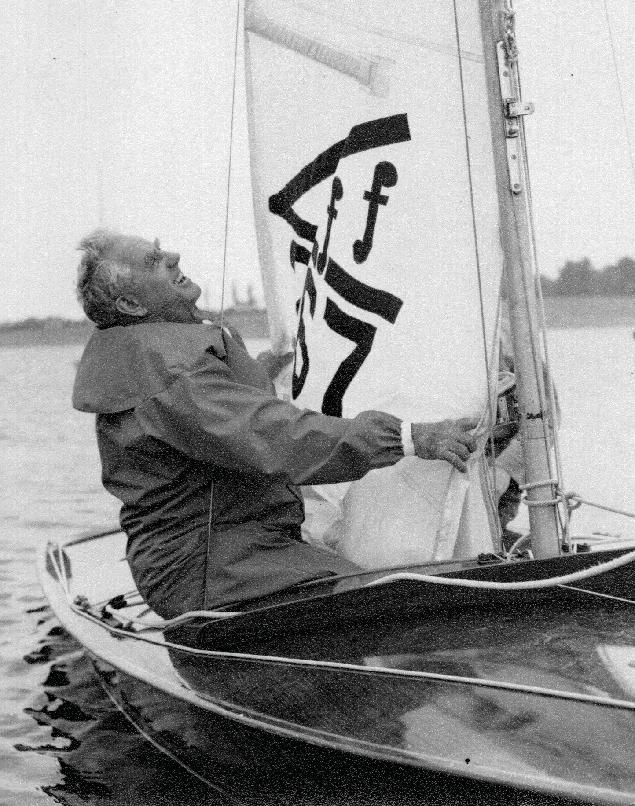
CCYC does its best to accommodate visiting Fifteens for both Cowes Week and Cowes Classics Week but as the local fleet continues to build again space is in great demand so it is advisable to enquire early if interested to secretary@ccyc.org.uk Whatever event interests you Cowes looks forward to welcoming Fifteens in 2022.
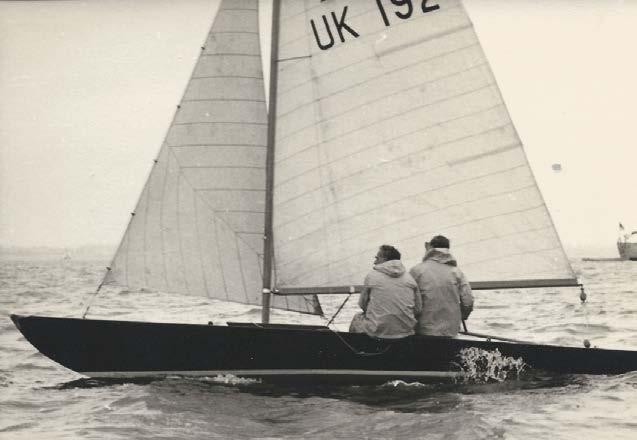
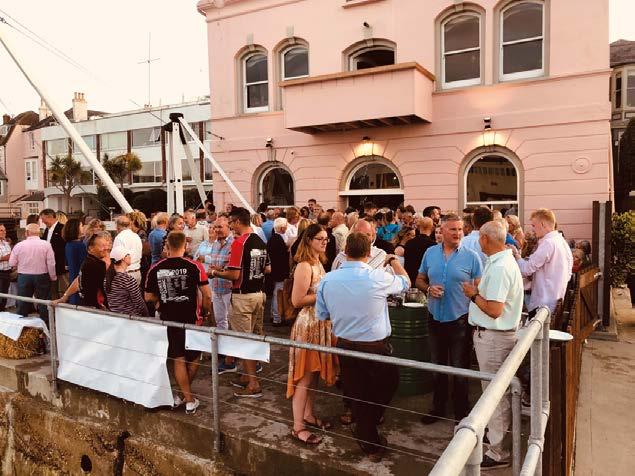

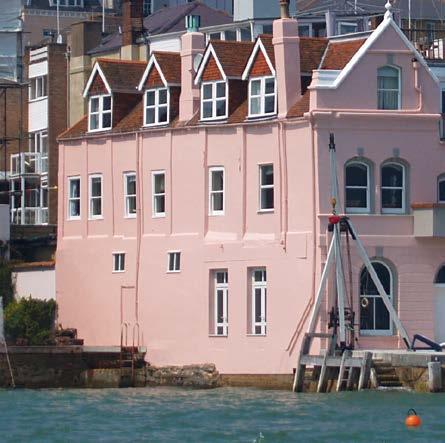
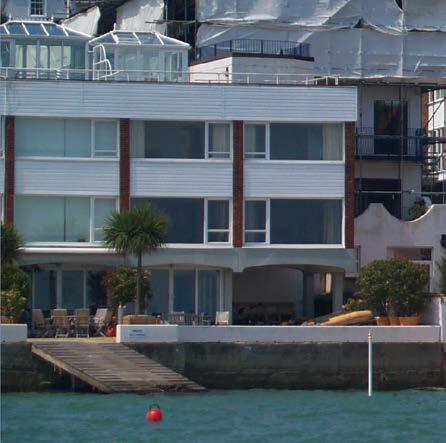

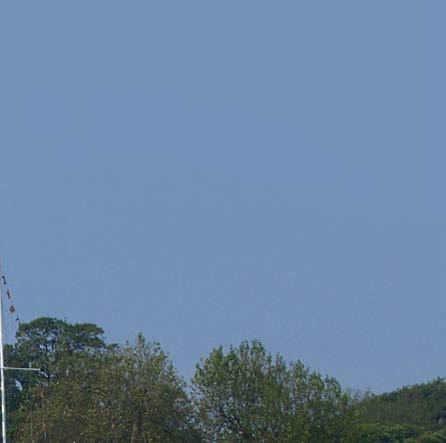


FLYING FIFTEEN WORLD — FEBRUARY 2022 27
Hong Kong Flying Fift ns
Flying Fift ns
Newcomers shine at the 2021 Cla Championships
Newcomers shine at the 2021 Cla Championships Hong Kong
Sixteen boats took part in the 2021 Hong Kong Flying Fifteen Class Championships over the weekend of Dec 11-12. The fleet included a record nine mixed crews. Racing took place in Victoria Harbour in beautiful sunny weather. A total of six races were sailed in a mixture of testing wind and tidal conditions.
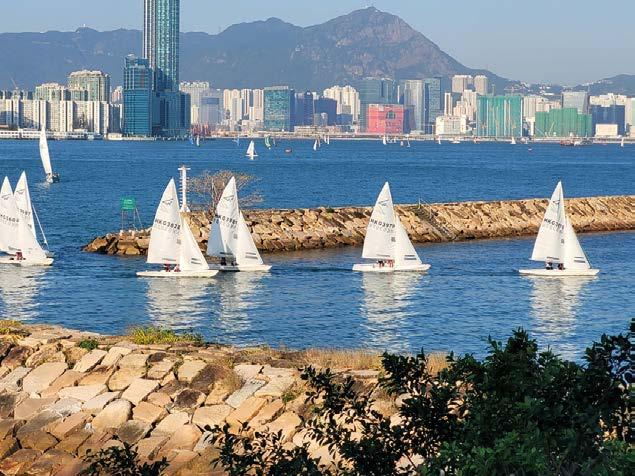
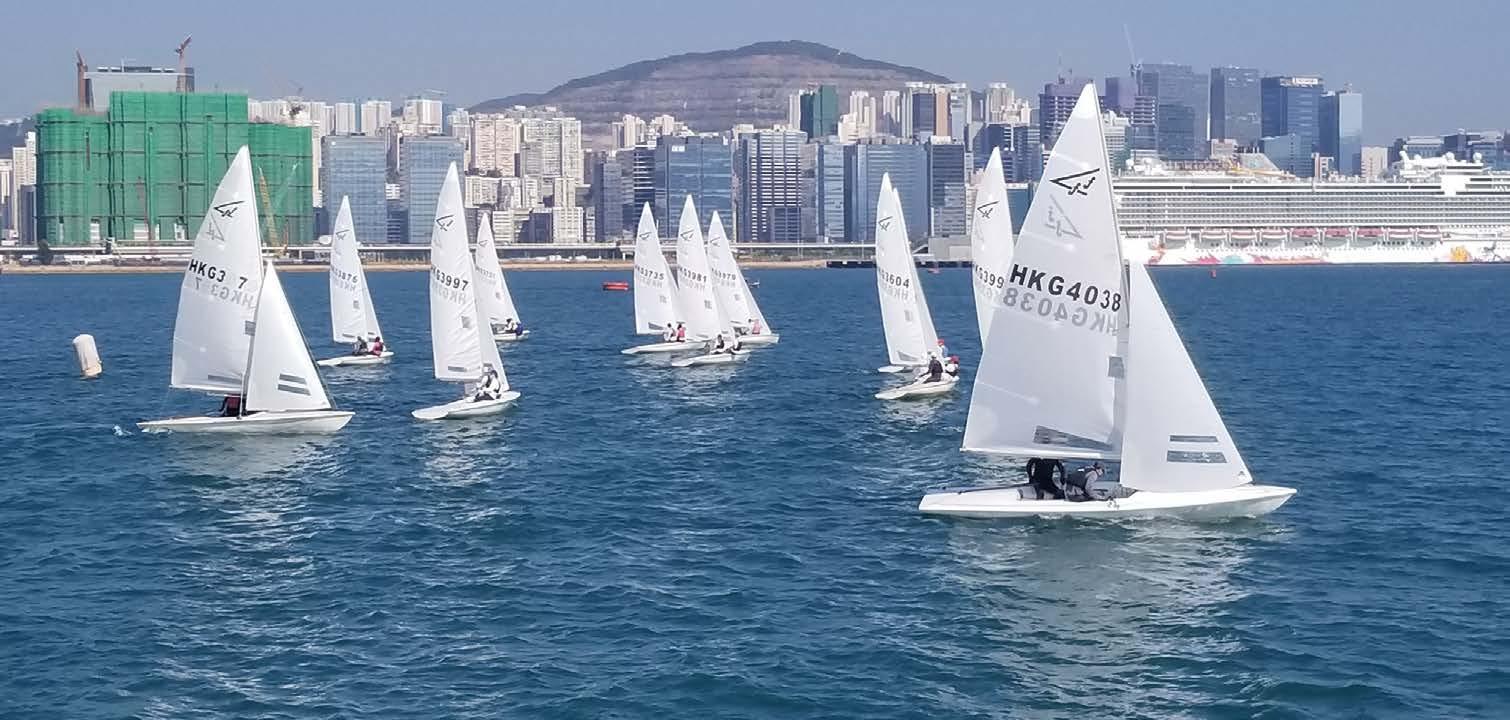
Pete Britten and Ollie Merz (3722) were worthy winners of the Championship. The story of the weekend however was the results of the newcomers to the Hong Kong fleet.
Day 1
A steady northeasterly breeze of 15 knots, a strong flood tide and choppy sea state greeted the first day of racing. Theme for the day was short tacking up the shore and picking lay lines across the channel.
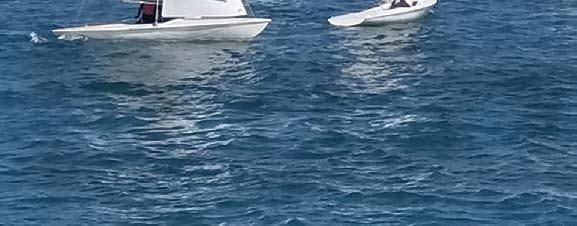
The Championship kicked off with a super quick windward-leeward course. Three newcomers to the Hong Kong fleet swept the top 3 spots - James and Jim (3990) in first, Gina and Josh (3981) second, followed by Pete W and Marie (4015) third. Unfortunately, guest Ruffian sailors Oliver and Christina (3604) had a technical issue and were forced to return to the dock.
The second race was action packed. Gina and Josh (3981) broke their tiller extension and quickly resorted to sail tie and electrical tape - spirits were however not broken! The windward mark now in strong tide made picking lay lines a challenge. There were a few close calls, some light grazes, plenty of shouting and several penalty turns, including a heated debate as to the required number of turns! (names withheld to avoid embarrassment).
The final race of the day included a fleet favourite, the fast (and a little bit hairy!) reaching leg. Plenty of overtaking opportunities at the gybe mark. There was a photo finish for second with Tom and Beto (3997) pipping Tim and Edith (3876) by one second. It was great to welcome Tom back from a long hiatus.
After a day of hiking, the sailors returned to the Club to enjoy (socially distanced) ice cold drinks before heading home to get some much-needed rest.
Day 2
Sailors woke, some refreshed, some hungover, to much lighter conditions. A shifty 7 knot northeasterly breeze with a building tide. Leaving the typhoon shelter was the first challenge. The annual Hong Kong cross harbour swim forced the fleet to take an unexpected detour through all the moored boats.
Race 4 was a game of snakes and ladders in the light breeze and
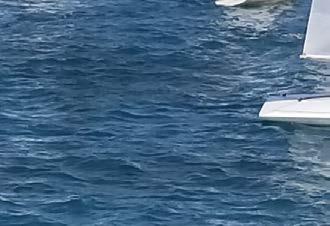
tide. Sam and Kingston (4038) confidently led the first lap. James and Jim (3990) rounded the leeward mark in the back half of the fleet and decided to hit a corner and split the fleet. The strategy paid off overtaking the entire fleet. They rounded in first followed by Sam and Kingston (4038). The dueled continued on the last downwind leg, with Sam and Kingston (4038) just taking their first win of the weekend by seconds. Pete B and Ollie (3722), the overnight leaders recovered to a creditable third followed by “Ruffian Oliver” (3604) in fourth.
The breeze was now softening with the relentless tide. A two lap windward-leeward sprint was set for Race 5. Pete B and Ollie (3722) secured their third bullet of the series and with it the overall Championship. Wai Chuen and guest crew Rita (3476) were particularly pleased with their fantastic third place.
The final race of the weekend started in very shifty conditions, the kind that drives crews nuts in the Hong Kong summer. Carlyon and Lucy’s (3979) light air skills came to the fore. They took their first win which moved them to third in the overall Championship. James and Jim (3990), one of the “newbie crew”, were second and became Championship runners up. David and Michael (3701) had their best result with a great third place to round out their regatta.
With the Championship completed the fleet drifted home to much needed refreshments, food and the sharing of stories. Special thanks to Peter and Jarl, the race officers, for overseeing a successful Championship and to the Flying Fifteen Class Secretary Tim Roberts and the rest of the committee for organizing the two-day event.
FLYING FIFTEEN WORLD — FEBRUARY 2022 28
FFI-ACT Inc. 53rd ACT Flying Fifteen Championship FFI-ACT Inc. 53rd ACT Flying Fifteen Championship




The 53rd ACT Flying Fifteen Championship was sailed on Lake Burley Griffin over Saturday 13th and Sunday 14th November 2021. Th e Championship was held in conjunction with the ACT Dinghy Championship, this year organised by The YMCA of Canberra Sailing Club. Five races were completed, with 4 to count.

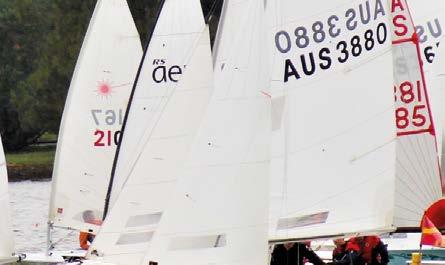
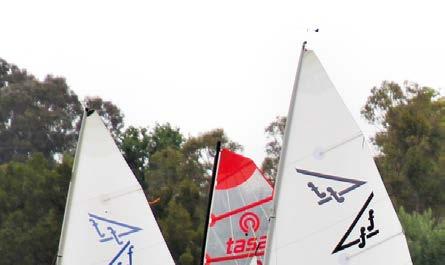
The Championship was won by past ACT Flying Fifteen Champions Ian and Craig Rainey from the Gippsland Lakes Yacht Club. Runners up were defending Champions from 2020,
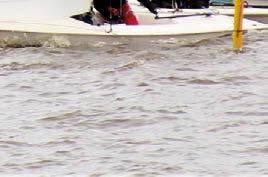
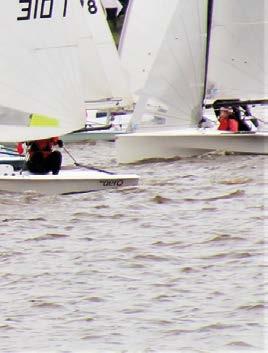
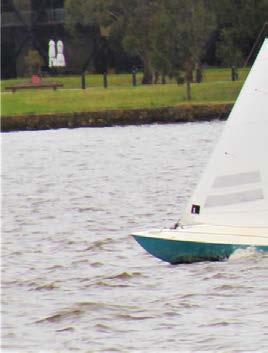
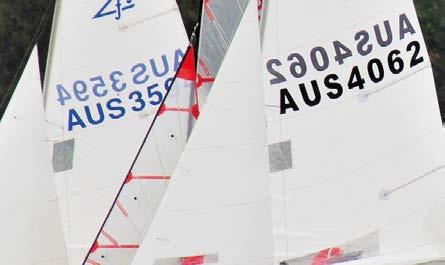
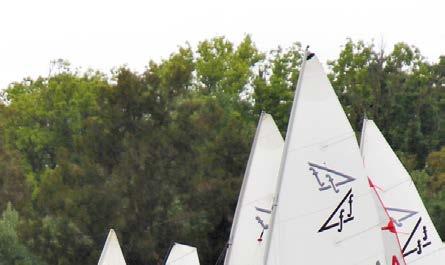
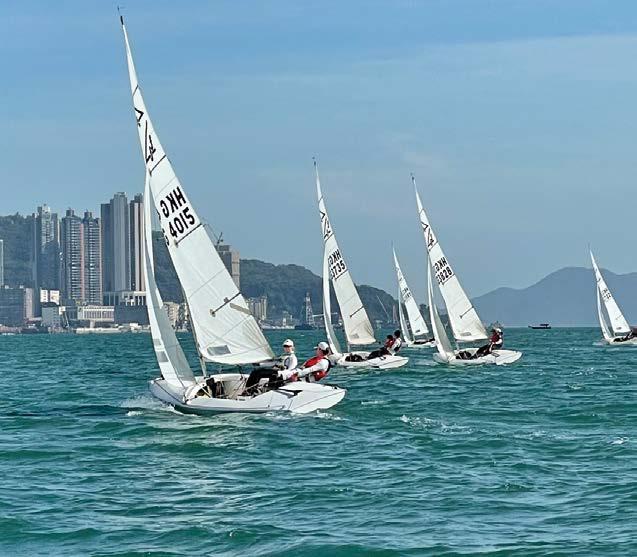
Chris Villa and Mark Holmes from the Lake Macquarie Yacht Club while third place went to Matthew Mitchell and Simon McCowan from the Canberra Yacht Club.
The ACT Flying Fifteen Association much appreciated the participation by our interstate visitors especially on a weekend where the forecast for the ACT and many areas in Victoria and NSW was for cold days, widespread rain and strong winds – elements which, while certainly prevailing during the Championship, helped contribute to some close and exciting racing.
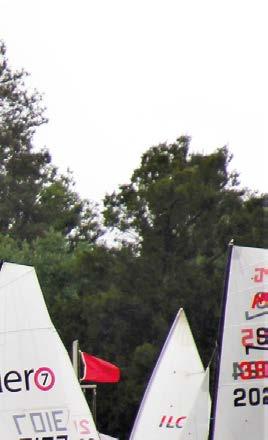
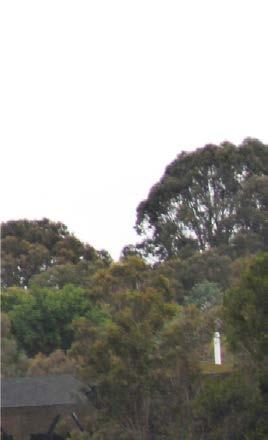
Rank Helm Sail No. Points 1st P Britten 3722 10.0 2nd J Betts 3990 13.0 3rd C Knight-Evans 3979 22.0 4th S Chan 4038 23.0 5th T Sheppard 3997 24.0 6th T Roberts 3876 27.0 7th G Chen 3981 30.0 8th D Chow 3701 30.0 9th WC Chan 3476 44.0 10th Y Kirihara 3735 50.0 11th O Cully 3604 58.0 12th J Komatsu 3828 59.0 13th P Wilkinson 4015 67.0 14th S Suen 3978 71.0 15th T Lee 3649 73.0 16th B Tam 3700 76.0
Race 1. Start.
FLYING FIFTEEN WORLD — FEBRUARY 2022 29
Overall Results:
AUS 3880. WTBHAY*. C & I Rainey, GLYC. DSQ, 2, 1, 1, 1 5 points
AUS 4062. Up Ship Creek. C Villa & M Holmes, LMYC. 1, 1, (3), 2, 2 6 points
AUS 3657. Super Snabb. M Mitchell & S McCowan, CYC. 2, 3, (4) ,3 ,3 11 points
AUS 3594. Relience Ffeighteen, P Forster & G Anderson, CYC. 3, 4, 2, DNS, DNS
AUS 3620. Maybe Knot. B McLennan & P Strauch, CYC. 4, 5, 5, DNS, DNS
*Where The Bloody Hell Are You?
In all five races, there was little between the leading yachts at each mark and at the finish leading to some enthralling upwind and downwind duels.
Day 1. Saturday 13th November
Saturday’s 3 races were held under cold and cloudy conditions with lengthy periods of light drizzle. Wind was predominantly NW to WNW, averaging 7 to 10 knots with gusts up to 15 knots for the first two races, while lighter conditions prevailed for the third race.
The Flying Fifteens sailed in Division 2, along with several other classes of dinghy. A General Recall in Race 1, meant the restart was relegated to follow Division 6. Relience Ffeighteen had the best start and led for the first two legs, but then WTBHAY took the lead, closely followed by Up Ship Creek, Super Snabb, Relience Ffeighteen and Maybe Knot. During Lap 3, Up Ship Creek overtook WTBHAY, but this lead was relatively short-lived and WTBHAY went on to finish about 30 seconds ahead of Up Ship Creek, with Super Snabb just holding off Relience Ffeighteen for third place. (WTBHAY was, however, DSQd by the race officials (under the ‘black flag’ rule), relegating Up Ship Creek to first place.)
Relience Ffeighteen again had the slight advantage at the start of Race 2, followed by WTBHAY and Up Ship Creek. The yachts split tacks on the beat but neither side of the Lake proved advantageous and there was little between the five at Mark 1. After rounding Mark 2, the wind eased off on the downward leg. WTBHAY held the lead until the final downward run, when Up Ship Creek found some extra breeze and went to the lead, which was held until the finish, holding off a fast-finishing WTBHAY with Super Snabb taking third place.
A blustery squall swept across the Lake between the finish of Race 2 and the start of Race 3, after which the wind dropped further, averaging around 7 knots. Thankfully the drizzle also stopped. Maybe Knot and Relience Ffeighteen had the best of the start. At the top mark, Relience Ffeighteen and WYBHAY rounded together followed by Up Ship Creek, Maybe Knot and Super Snabb. As the race progressed, Relience Ffeighteen kept within striking distance of WTBHAY closely followed by Up Ship Creek. On the second downward run, Relience Ffeighteen opted not to fly their spinnaker, allowing Up Ship Creek to round the bottom mark slightly ahead, but subsequently Relience Ffeighteen worked their way back into second place. WTBHAY crossed the finish line first, followed by Relience Ffeighteen, Up Ship Creek, Super Snabb and Maybe Knot.
Day 2. Sunday 14th November
A cold Sunday morning saw very strong westerly winds whipping up white capped waves on the Lake, with rain threatening. As start time of 11am approached, the wind was blowing at around 15 knots on average with gusts over 20 knots. The number of yachts on the Lake was clearly far fewer than for Saturday’s races. For the Flying Fifteens, Maybe Knot had to pull out when the halyard rope broke as the main was being hoisted, while Relience Ffeighteen also remained on-shore.
With three races having been completed on Day 1 in a five-race series, the suitably well protected Flying Fifteen crews set off for a morning of exciting racing.
Up Ship Creek had the better of the start in Race 4 and just held the lead over WTBHAY at Mark 1. WTBHAY was first to fly their spinnaker on leg 2 and overtook Up Ship Creek. The three yachts flew their spinnakers on the run to Mark 3 in tricky wind conditions with gusts at times reaching 24 knots and then the wind dropping off to 10-12 knots. Up Ship Creek was first to round Mark 3, followed by WTBHAY and Super Snabb.
The rescue boats were kept very busy with many dinghies capsizing or running for shelter. The Flying Fifteens, however, revelled in the conditions.
Up Ship Creek maintained the lead for the next lap, aided by a downwind broach by WTBHAY, at much the same time as a gust was recorded in the CYC Tower at 29.6 knots. WTBHAY, however, overtook Up Ship Creek on the last windward leg and with the wind dropping off to around 10 knots, held on to finish ahead of Up Ship Creek and Super Snabb.
With the wind once again strengthening, an even fewer number of yachts turned up for the Divisional starts of Race 5. Up Ship Creek led from the start and maintained a clear lead over WTBHAY throughout lap 1. At one stage during the race, a gust of over 30 knots was recorded in the CYC Tower. On lap 2, WTBHAY made up some ground but Up Ship Creek still held the lead and looked the winner as the yachts approached the finish line. A mishap by Up Ship Creek while gybing with about 100 metres to go to the line, however, allowed WTBHAY to take the lead for the first time in the race and secure the win followed by Up Ship Creek and Super Snabb.
Following the races, FFI-ACT President Peter Forster, presented the ACT Flying Fifteen Championship Trophy to Craig and Ian Rainey, with prizes also presented to Chris Villa and Mark Holmes and Mathew Mitchell and Simon McCowan.
WTBHAR was also placed third in Division 2 of the ACT Dinghy Championship, behind a Tasar and a Laser.
FLYING FIFTEEN WORLD — FEBRUARY 2022 30

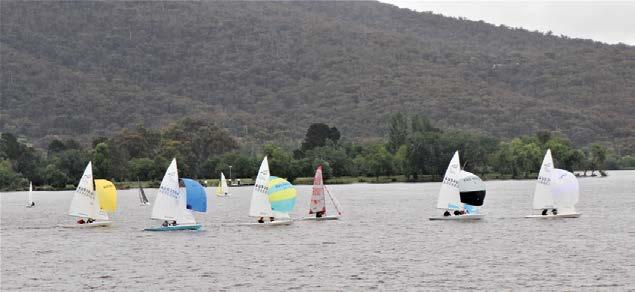
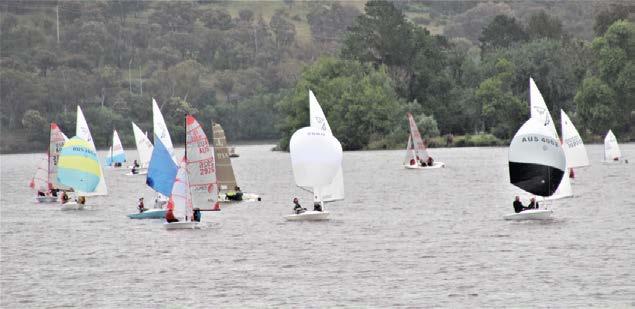
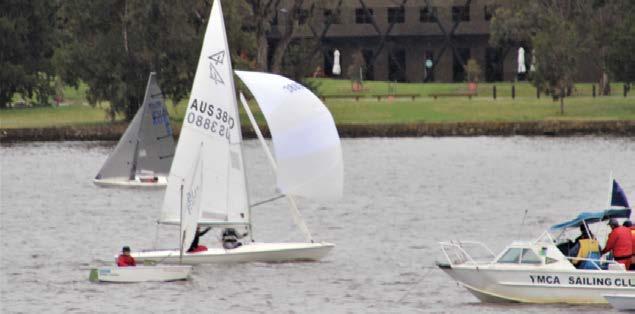
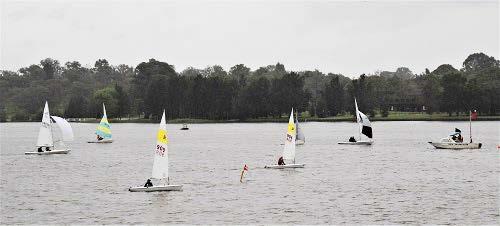
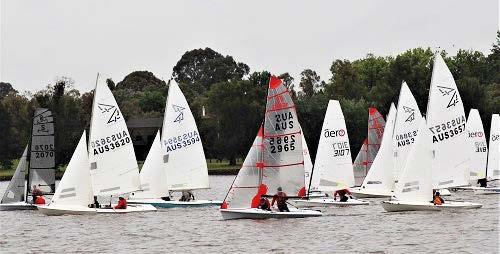
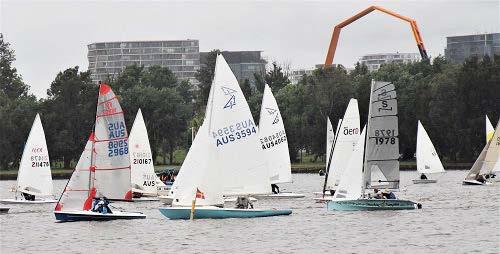
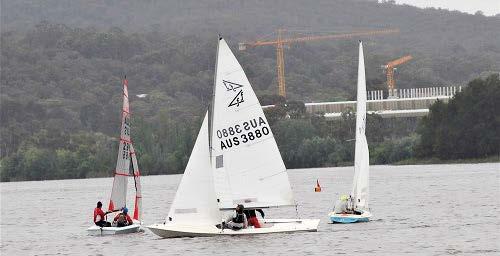
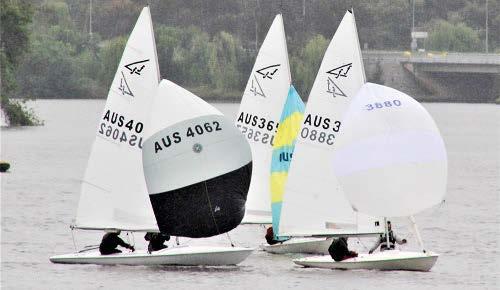
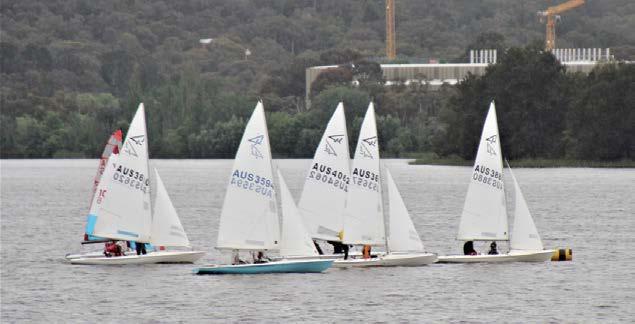 Race 1. Reach Mark 1 to Mark 2.
Race 2. Start
Race 2. Approaching Mark 1
Race 2. Downwind Mark 2 to Mark 3
Race 2. Finish
Race 3. Start
Race 1. Downwind Mark 2 to Mark 3
Race 1. Rounding Mark 3
Race 1. Up Ship Creek has the lead
Race 1. Reach Mark 1 to Mark 2.
Race 2. Start
Race 2. Approaching Mark 1
Race 2. Downwind Mark 2 to Mark 3
Race 2. Finish
Race 3. Start
Race 1. Downwind Mark 2 to Mark 3
Race 1. Rounding Mark 3
Race 1. Up Ship Creek has the lead
FLYING FIFTEEN WORLD — FEBRUARY 2022 31
Race 1. WTBHAY crosses the finish line in first place (subsequently DSQd)
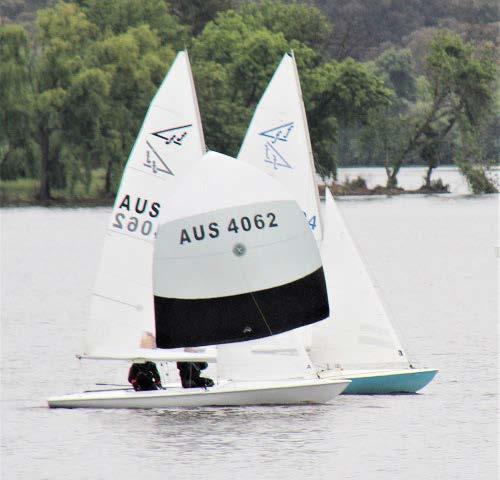
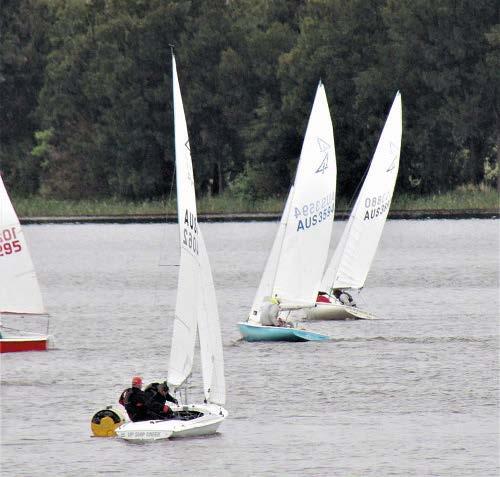
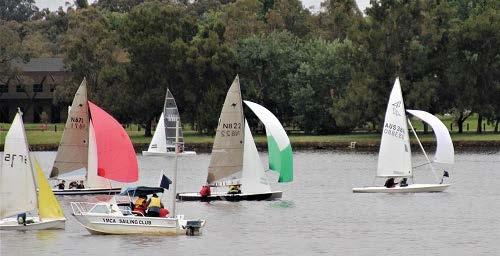

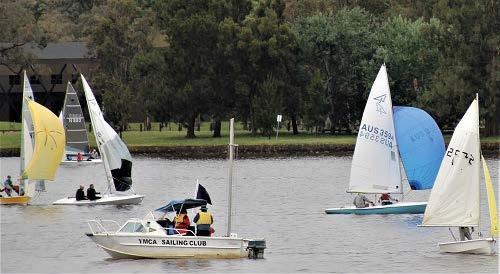
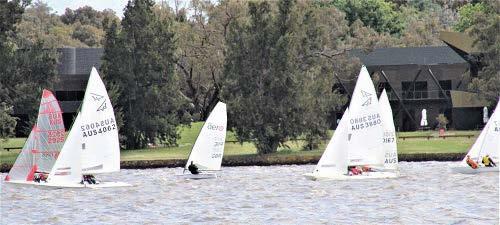
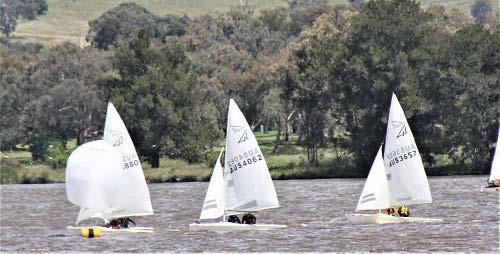
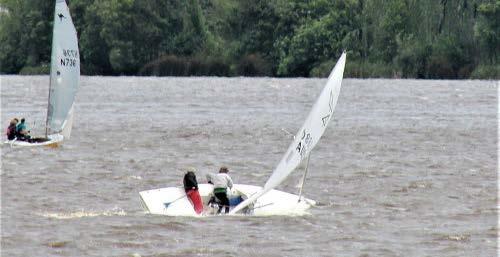 Race 3. 3594 on stern of 3880
Race 3. 3880 crosses finish line
Race 3. 3594 ahead of 4062 at the finish
Race 4. 4062 leads 3880 just after start
Race 4. 3880 leads at Mark 2
Race 4. 3880 hanging on
Race 3. 4062 overtakes 3594
Race 3. 3594 on stern of 3880
Race 3. 3880 crosses finish line
Race 3. 3594 ahead of 4062 at the finish
Race 4. 4062 leads 3880 just after start
Race 4. 3880 leads at Mark 2
Race 4. 3880 hanging on
Race 3. 4062 overtakes 3594
FLYING FIFTEEN WORLD — FEBRUARY 2022 32
Race 3. 3880 leads 3594 and 4062 at Mark 3

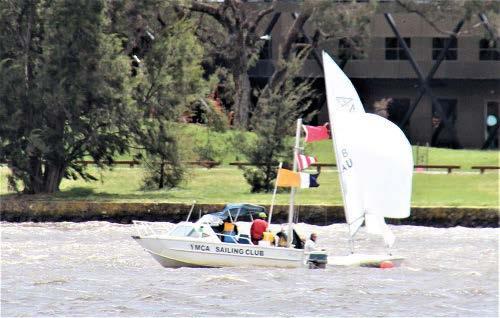
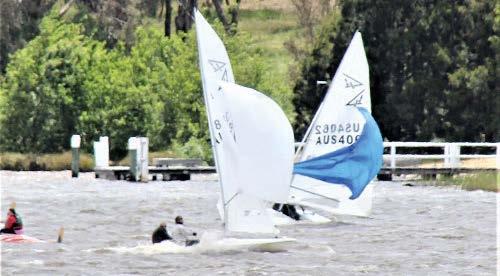
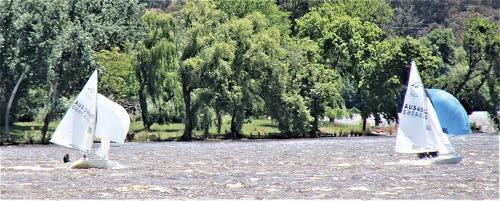
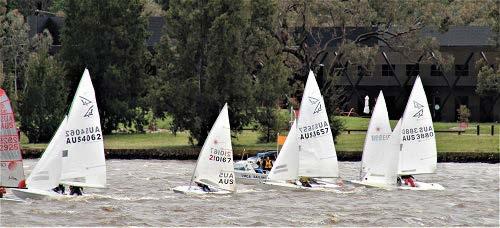

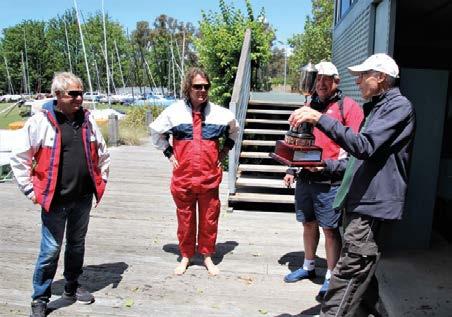
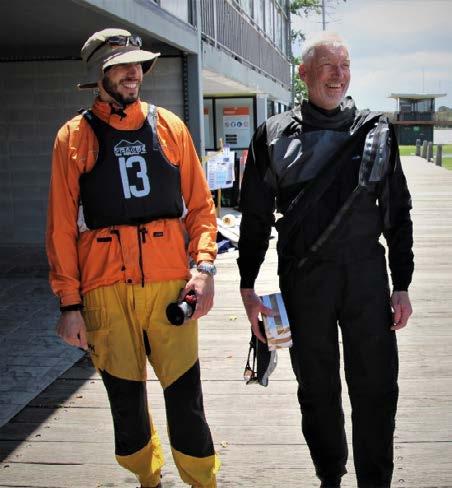
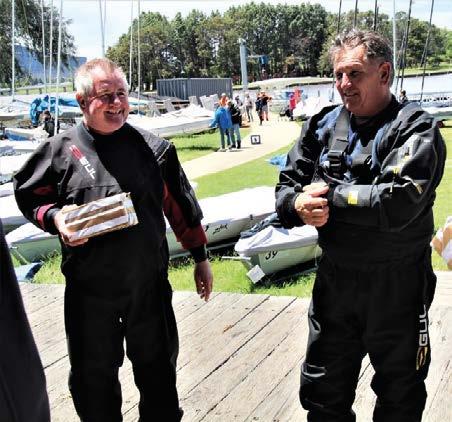 Craig and Ian Rainey
Chris Villa and Mark Holmes
Matthew Mitchell & Simon McCowan
Peter Forster presenting the Championship Trophy
Race 4. 3880 a clear but close winner
Race 5. Start
Race 5. On final run
Race 5. Mishap on 4062 allows 3880 to take lead
Craig and Ian Rainey
Chris Villa and Mark Holmes
Matthew Mitchell & Simon McCowan
Peter Forster presenting the Championship Trophy
Race 4. 3880 a clear but close winner
Race 5. Start
Race 5. On final run
Race 5. Mishap on 4062 allows 3880 to take lead
FLYING FIFTEEN WORLD — FEBRUARY 2022 33
Race 5. 3880 takes final race
Conamara Flying 15s Conamara Flying 15s
Cumann Flying Fifteens Chonamara is based in Casla Bay in the Conamara Gaeltacht area in County Galway. We are fortunate to be able to sail in such a beautiful location on the west coast of Ireland, with views of the Aran Islands and the Burren from the bay.
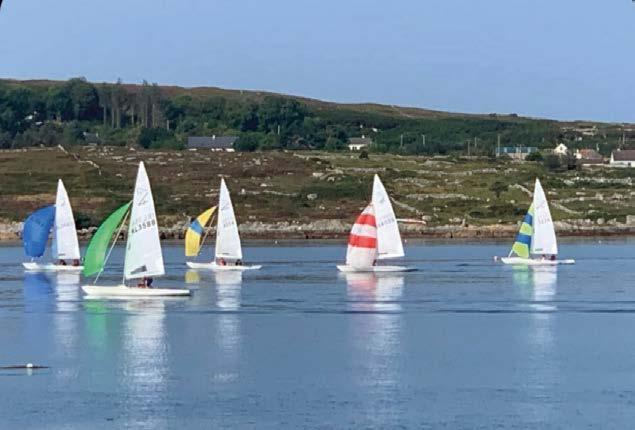

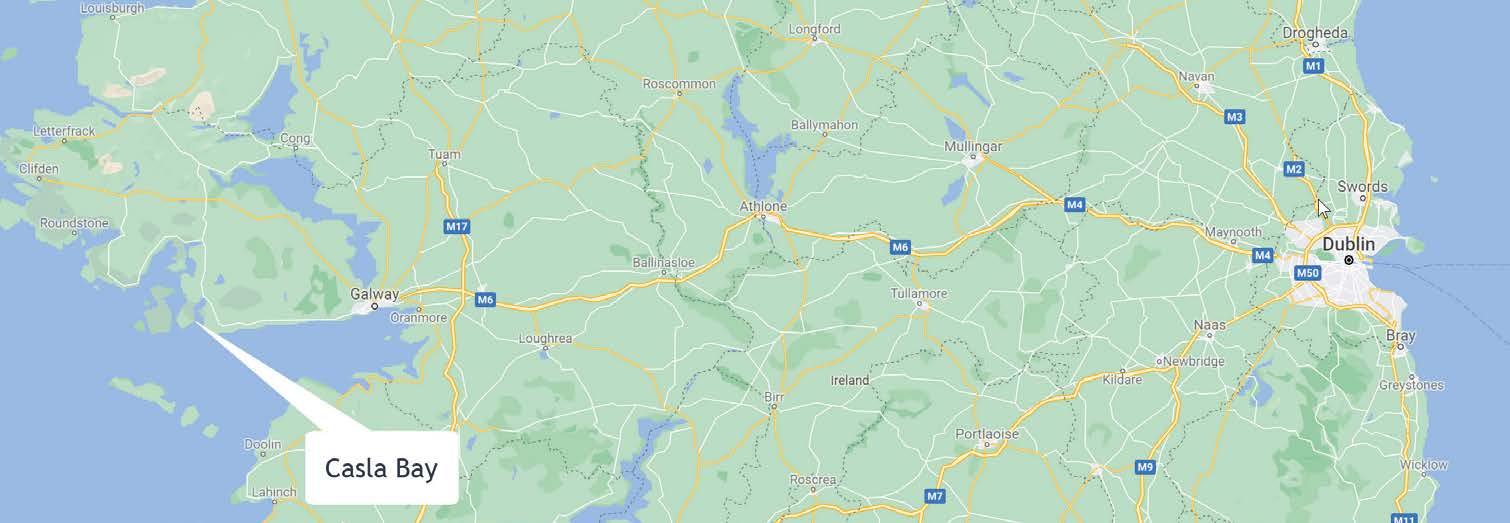
The first Flying Fifteens came to the area around 1997, where the design and ease of handling appealed to the local sailors with many that sailed in the traditional Galway Hookers also owning a Flying Fifteen. The class grew steadily with around fourteen actively racing, however the class declined in the mid 2000s with many of the boats lying inactive, and what were once regular races on a weekly basis dwindled to one or two races per season with only a handful of boats participating. There were several efforts to revive the class but it was largely thanks to setting up social media pages for the club to promote the class in 2018 that interest in the class developed again, with a large number of younger members this time around and twenty seven boats registered with the club.
Our current members range from the age of thirteen to sixty five and there is a broad span of experience. There is a wide range in the age of the boats in the fleet also, with some of the newer ones including Buckfast (3621) and Friday Feeling (3704) and the oldest in the fleet Susule (1256). Some of the boats are still with the original owners from when the club started, such as Simply Red (3203) and Bonzai (3124). The use of social media to promote the club has greatly assisted in improving participation of existing members and attracting new members and boats to the fleet.
We run a league from April to September with weekly races every Friday. This year we ran two shorter leagues for the season, which include a race into Kilronan in Inis Mór, the largest of the Aran Islands and finished off the season with a race from Sruthán in Casla Bay to Caladh Thadhg in Greatman’s Bay. Two of our members, Niall and Rónán O’Brien also had great success in Lough Derg Yacht Club’s Freshwater Keelboat Regatta in October with a fantastic result of second out of a fleet of ten. The club is very proud of them and the result reflects the club’s ambition to keep improving. We hope in the future to host a regatta open to other Flying Fifteen clubs to encourage our members to compete and to continue improving.
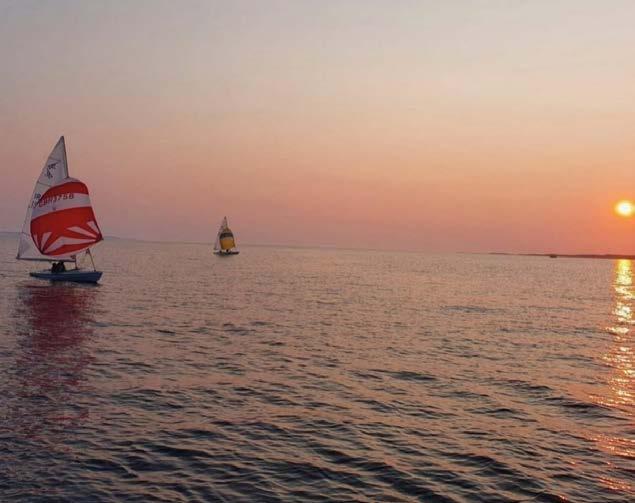 The start of our end of year race from Sruthán in Casla Bay to Caladh Thadhg in Greatman’s Bay
The start of our end of year race from Sruthán in Casla Bay to Caladh Thadhg in Greatman’s Bay
FLYING FIFTEEN WORLD — FEBRUARY 2022 34
Returning home from the race into Kilronan, Inis Mór in August
MULTIPLE
Innovation using the latest design software, quality in manufacturing and competitive pricing. Get the winning edge in 2022.
• NEW MAINSAIL DESIGN FOR 2022.
• NEW COVERS DESIGNS AND MATERIAL FOR 2022.
• NEW ACCESSORIES FOR 2022. Visit hydesails.co.uk for more information on our full range of Flying 15 products and for our latest 2021 tuning guide.
CONTACT: BEN MCGRANE
Tel: 07421 065527 or 02380 457779
benmcgrane@hydesails.co.uk | hydesails.co.uk
1 965
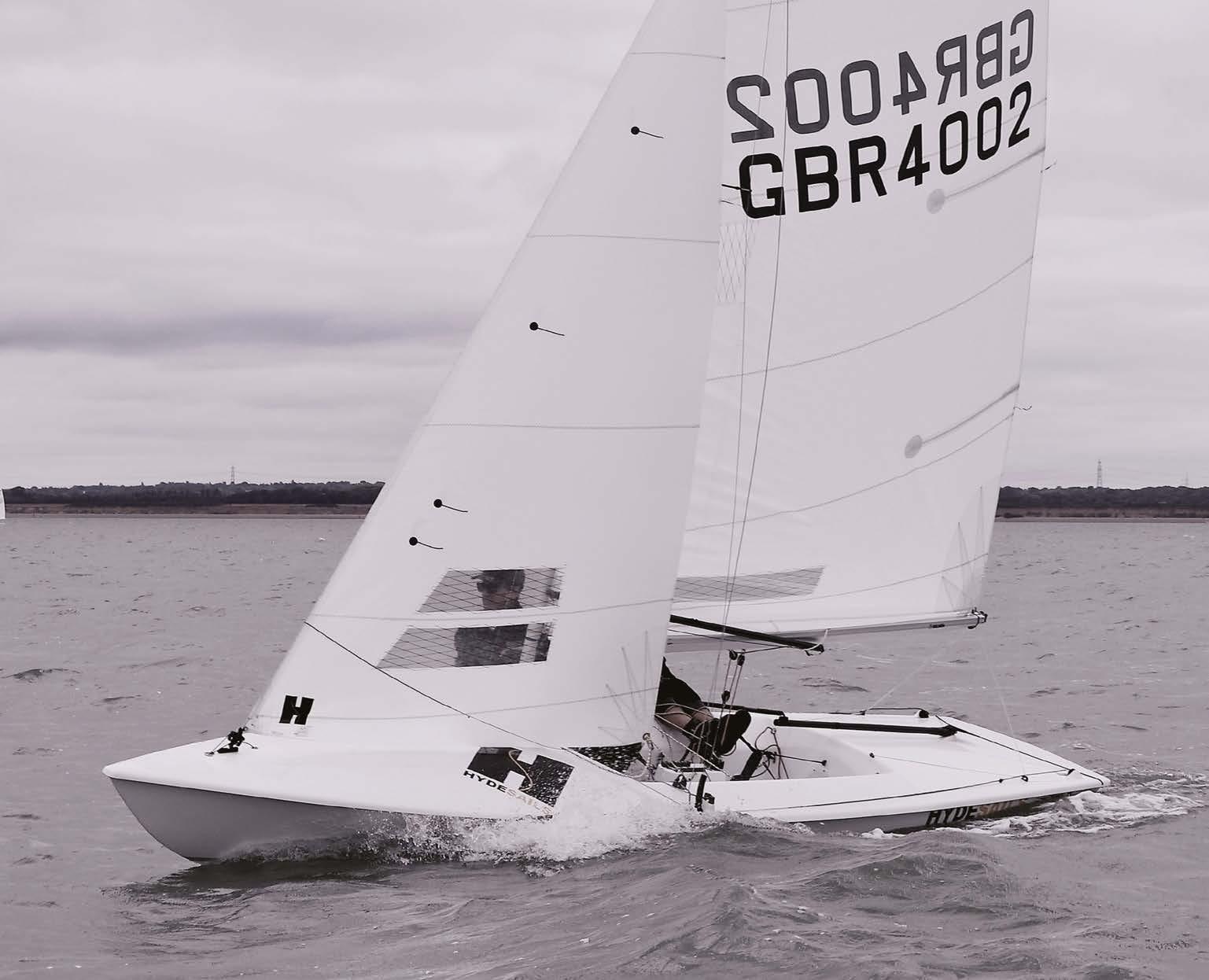
FLYING FIFTEEN WORLD — FEBRUARY 2022 35
CHAMPIONSHIP WINNING SAILS! est
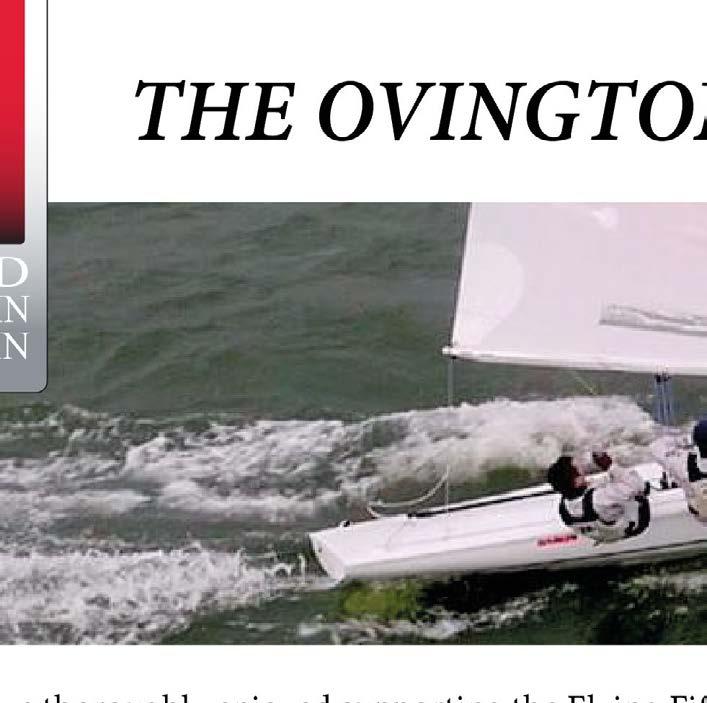
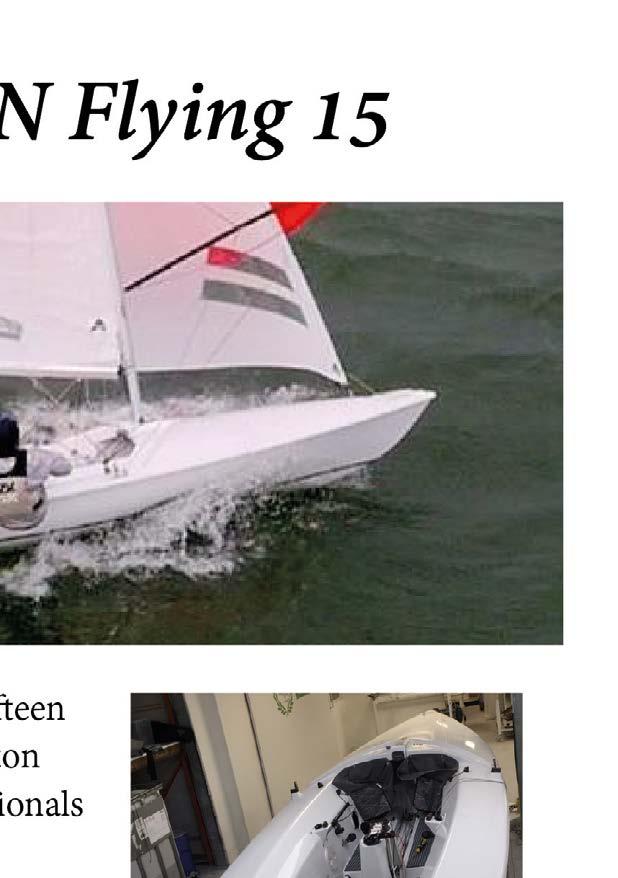
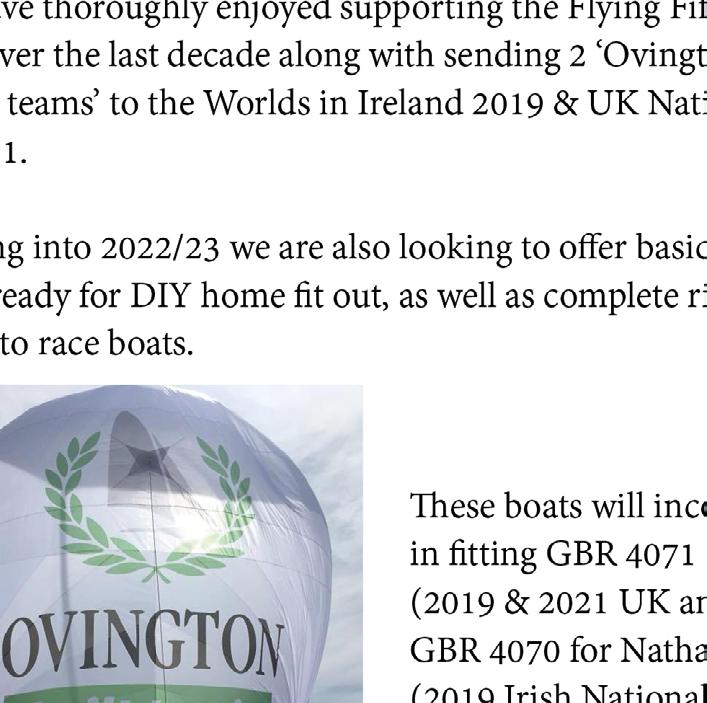
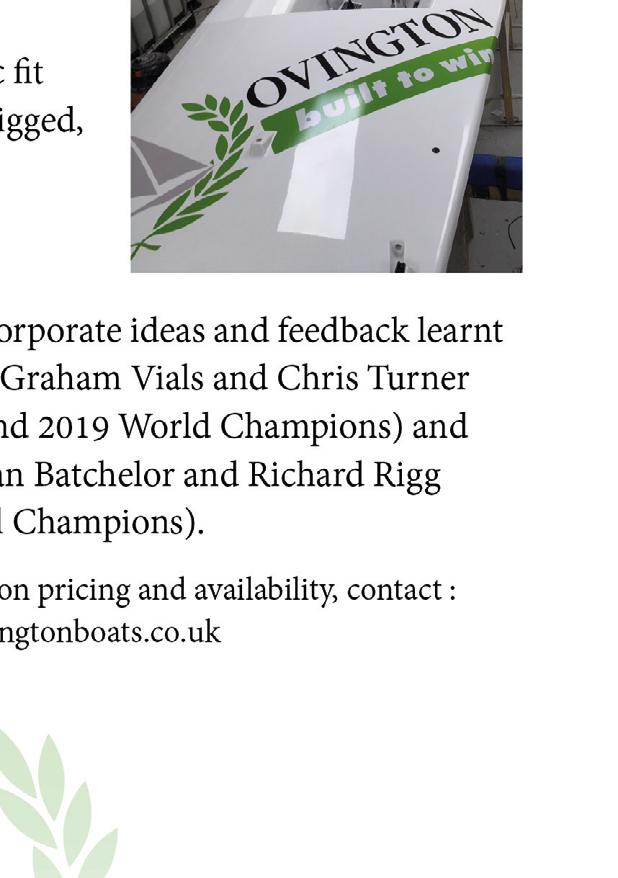


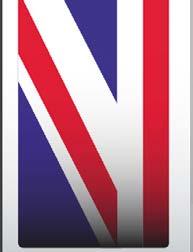

FLYING FIFTEEN WORLD — FEBRUARY 2022


























































































 Alan Br kes
Alan Br kes
















































 3.
4.
5.
7.
9.
6.
8.
3.
4.
5.
7.
9.
6.
8.

























































 Race 1. Reach Mark 1 to Mark 2.
Race 2. Start
Race 2. Approaching Mark 1
Race 2. Downwind Mark 2 to Mark 3
Race 2. Finish
Race 3. Start
Race 1. Downwind Mark 2 to Mark 3
Race 1. Rounding Mark 3
Race 1. Up Ship Creek has the lead
Race 1. Reach Mark 1 to Mark 2.
Race 2. Start
Race 2. Approaching Mark 1
Race 2. Downwind Mark 2 to Mark 3
Race 2. Finish
Race 3. Start
Race 1. Downwind Mark 2 to Mark 3
Race 1. Rounding Mark 3
Race 1. Up Ship Creek has the lead







 Race 3. 3594 on stern of 3880
Race 3. 3880 crosses finish line
Race 3. 3594 ahead of 4062 at the finish
Race 4. 4062 leads 3880 just after start
Race 4. 3880 leads at Mark 2
Race 4. 3880 hanging on
Race 3. 4062 overtakes 3594
Race 3. 3594 on stern of 3880
Race 3. 3880 crosses finish line
Race 3. 3594 ahead of 4062 at the finish
Race 4. 4062 leads 3880 just after start
Race 4. 3880 leads at Mark 2
Race 4. 3880 hanging on
Race 3. 4062 overtakes 3594








 Craig and Ian Rainey
Chris Villa and Mark Holmes
Matthew Mitchell & Simon McCowan
Peter Forster presenting the Championship Trophy
Race 4. 3880 a clear but close winner
Race 5. Start
Race 5. On final run
Race 5. Mishap on 4062 allows 3880 to take lead
Craig and Ian Rainey
Chris Villa and Mark Holmes
Matthew Mitchell & Simon McCowan
Peter Forster presenting the Championship Trophy
Race 4. 3880 a clear but close winner
Race 5. Start
Race 5. On final run
Race 5. Mishap on 4062 allows 3880 to take lead



 The start of our end of year race from Sruthán in Casla Bay to Caladh Thadhg in Greatman’s Bay
The start of our end of year race from Sruthán in Casla Bay to Caladh Thadhg in Greatman’s Bay








